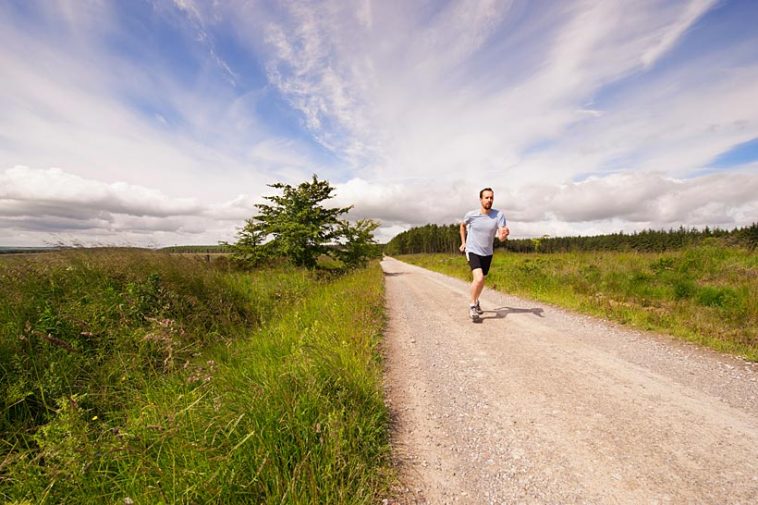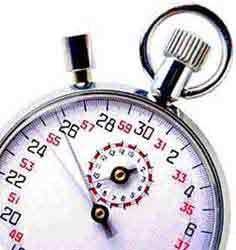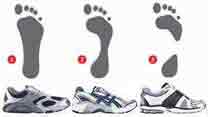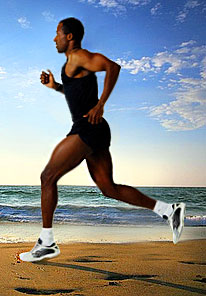- Like
- SHARE
- Digg
- Del
- Tumblr
- VKontakte
- Flattr
- Buffer
- Love This
- Save
- Odnoklassniki
- Meneame
- Blogger
- Amazon
- Yahoo Mail
- Gmail
- AOL
- Newsvine
- HackerNews
- Evernote
- MySpace
- Mail.ru
- Viadeo
- Line
- Comments
- Yummly
- SMS
- Viber
- Telegram
- JOIN
- Skype
- Facebook Messenger
- Kakao
- LiveJournal
- Yammer
- Edgar
- Fintel
- Mix
- Instapaper
- Copy Link
Beginning a Running Exercise Program

Start Off On the Right Foot!
If you’re interested in information about running for beginners, there are some important things that you must be keeping in mind at all times to ensure that you see nothing but the best results from this new form of training.
Many will dive into a running exercise program for beginners without being fully prepared and in turn will sometimes suffer devastating consequences. Either they wind up sidelined due to injury or get burnt out very quickly.
Beginner runners often kick off this new form of training with a high level of motivation and enthusiasm, however, due to this desire to push forward relentlessly, they end up developing what’s called overtraining syndrome in the exercise world.
To set you off on the right foot, let’s go over a few of the key points that you should keep in mind when starting a running exercise program for beginners.
Take It At a Comfortable Pace 
The very best piece of advice I recommend you adhere to when beginning a running exercise program is to take it at a comfortable pace. Even if you do have a bit of background in running, don’t try and go for a 30 minute run the very first week.
Instead, build up to this. You’re going to enjoy the process a lot more if you’re doing comfortable runs and will find that you reach your end goal sooner as well.
If you do decide to follow a structured running program for beginners, make sure that you choose one that is appropriate for your background experience. There will be a running exercise program for those who have run before in the past and a running exercise program for beginners who haven’t ever partaken in this form of activity. Choose one that suits you best.
Look After Your Nutrition
Second, the next vital thing that you must do as you get started with a beginners running exercise program is to make sure that you’re looking after your nutrition.
If you’re consuming the wrong foods at the wrong times in the day, you may not have the energy to get through your scheduled runs.
Remember, running is a very intensive activity and will require carbohydrates for fuel. Don’t cut all the carbs out of your diet plan as you will need the energy they provide.
Time healthy carb sources before and after your run to support high levels throughout the run and a speedy recover. Pair this with some high quality protein and you’ll be all set.
Schedule Other Activities Wisely
Another must-do as you get started on your beginners running program is to make sure that you schedule other activities in wisely. It would be a good idea to get involved with some strength training workout as well, as these will help to develop the lean muscle mass and strength required to excel at running.
But, make sure that you’re also leaving enough time throughout the week for rest and recovery. One mistake that some people make after starting a running exercise program for beginners is adding all these runs to their normal weekly activities. This often presents them with exercise overload and many will get overtraining syndrome and possibly even end up in the cumulative injury cycle.
Remember, if you aren’t allowing enough rest between running sessions you’re just going to break your muscles down and move further from your goal, rather than closer.
Be sure to always have at least one full day off each week for rest and recovery. In time, you may even benefit from a full blown exercise recovery week.
Alternate Between Running & Walking
Finally, even if your goal is running, starting off with more of a beginners walking program is something to consider. Alternating between running, jogging, and walking workouts can go a long way towards helping you progress. For example, if you’re very new you’re going to find that you likely can’t run 5 days a week, so instead, go out for a walk on 2 of those days.
Walking is a great form of exercise as well and will serve to compliment any running exercise program for beginners. Walking will help you get more comfortable with physical activity in general and will prepare you for the higher intensity and increased wear and tear you’ll experience from running exercise.
So there you have it, all the main points to keep in mind as you progress through your beginners running exercise program. If you plan the program out well, make sure you’re looking after your nutrition, and then schedule enough down-time for relaxation and recovery, you can be guaranteed that this is just the beginning of your love affair with the sport of running or walking.
A Note On Proper Footwear 
If you are seeking advice on running for beginners, you should not underestimate the importance of proper footwear.
Since walking, jogging, and running are all repetitive motions, having the proper footwear (socks & shoes) is extremely important to prevent injuries, ranging from blisters to the dreaded plantar faciitis.
Due to the sedentary lifestyle, most adults have developed chronic muscle imbalances, which when combined with a running exercise program for beginners can wreak havoc on the entire body from the ankles to the lower back.
The key Message Here Is Don’t Skimp On Your Running Shoes
There is a wide variety of running shoe designs which help control to varying degrees the amount of pronation at the ankle. It is best to buy your running shoes at a specialty store where trained employees can analyze your gait and prescribe you the proper running shoe. Remember, the extra money you spend on a good pair of running shoes pales in comparison to the cost of a physical therapist.
If you’re on a tight budget or you don’t have a local runner’s store, you may also want to check out some of the top rated running shoes on Amazon or your favorite online retailer.
There are a great deal of quality, affordable running shoes for a decent price, if you know where to look. Just make sure you order shoes that fit you well. This is often an issue when ordering a pair of shoes off the Internet. If for some reason they don’t fit you properly, I highly recommend you take the extra time to return them right away for a pair that does. This will prevent potential problems down the road.
See Also:
Must Read Information in Addition to the Running Exercise Program for Beginners

Click Here for More Cardio Exercises Besides Running and Jogging
Learn the facts about how your body works. Take simple information and apply it to your exercise program to get fabulous results.- Click Here to Learn How to Create Challenging Interval Cardio Workouts
Learn ways to make your workouts more intense with cross training. Find some example workouts to help you improve your cardiovascular fitness quickly. Even those attempting running for cardio can cross train on other cardio machines. - Click Here to Learn About Treadmills for Jogging, Walking, and Running & Other Popular Cardio Machines
The tips for the beginners running program can be used outside or on a treadmill. Here are the best cardio machines for running and many other forms of cardio workouts.
Breathing Tips for Runners Who Want to Participate in Marathons
 Did you know that running on a routine basis can help you live a longer and healthier life? That’s right, a simple exercise that requires no equipment or extensive training can help you stay around long enough to see your grandchildren grow up!
Did you know that running on a routine basis can help you live a longer and healthier life? That’s right, a simple exercise that requires no equipment or extensive training can help you stay around long enough to see your grandchildren grow up!
Of course, running is one of the most difficult cardiovascular exercises that you can do. It’s quite taxing, which can turn a lot of people off on running altogether.
But what if we told you that there are a few simple breathing tips for runners that make the activity a bit easier? It sounds too good to be true, right?
Wrong!
In this article, we’ll break down a few things you can do to improve your breathing and make running easier. We’ll also tell you how this can positively affect your overall life.
Now then, let’s get started!
Train Your Body How to Breathe
If you want to make breathing easier, especially while running, you’re going to need to practice. This is something you can do every day, even while you sit at your desk, without really trying too hard.
Simply practice your breathing techniques until you notice you’re breathing properly without thinking about it. This will get you in better shape, too, as well as making running that much easier going forward.
If you feel that your breath doesn’t come as easily as it should, there could be an underlying problem. Getting an ABG interpretation can test how well your lungs are functioning and give some insight into any breathing difficulty you may be experiencing.
Slow Your Breathing Down
When you start running, go ahead and slow your breathing down early on. In other words, don’t wait until you start to feel tired or fatigued to focus on your breathing.
Playing catchup is never fun, especially if you don’t stop running while doing so. Getting your breathing right early on in your run will enable you to keep yourself going forward.
Find a Rhythm and Keep It
If you know anything about breathing exercises and breathing techniques, you know how important rhythm is. Keeping your breathing rhythm consistent will help ensure you’re taking in enough oxygen to fuel your body.
Again, try to find this rhythm and establish it early on when running. That way you can prevent yourself from burning out as fast when you’re running.
Basic Breathing Tips for Runners
Well, there you have it! Those are a few basic breathing tips for runners! So, if you’re having trouble breathing while running, keep these ideas in mind and see if you notice an improvement!
Remember, you can improve your breathing techniques away from the trails. So, practice breathing properly at home, at work, and whenever you think about so you can be better prepared for your next run.
When you do finally hit the trails, focus on your breathing early, and establish a rhythm within your first few steps. Also, make sure to keep that rhythm for the entirety of your run.
Looking for more healthy lifestyle tips and tricks? Check out our blog!
Safe Practices for Running a Marathon
 Whether you are preparing to run your 12th marathon or you are preparing for your first, there are certain precautions and after-care that you should know about.
Whether you are preparing to run your 12th marathon or you are preparing for your first, there are certain precautions and after-care that you should know about.
Marathons are an intense workout both mentally and physically, but the adrenaline rush that comes from successfully completing such a daunting task is worth the hard work it requires.
Protect Your Heart
Running long distances can be dangerous if your heart isn’t in top-shape. Our hearts need exercise, but extremely intense workouts aren’t always the safest for the heart. The American Heart Association says that 150 minutes of moderate exercise is great for the heart.
If you know that running a marathon is what you want to do, then it’s smart to have a check-up before beginning training. Although rare, people have died during or right after running a marathon. These deaths are most commonly linked to heart issues. Going to the doctor to have a check-up can help you know if your heart is physically capable to deal with the strains of running a marathon.
Show Some Love to Your Feet
Endurance runners often develop foot-related health issues. It’s important for marathon runners to have proper form when they run to prevent their feet from taking on any unnecessary extra pressure. Proper running form includes making sure the middle of the foot hits the sidewalk rather than the heel or the toe. It’s also important to be aware of your posture. Runners should always be looking ahead, not at the ground, have their shoulders straight, and allow their arms to pump in a comfortable and relaxed rhythm.
It is not uncommon for marathon runners to deal with plantar fasciitis, black toenails, tendinitis, or bunions. One way to protect your feet is to wear well-fitting supportive running shoes. A good running shoe should feel snug, but not overly tight, offer arch support, and have enough “stack” to help absorb the force of your foot hitting the ground with every step.
If you suffer from plantar fasciitis, black toenails, tendinitis, or bunions, a local foot doctor can help you work through these problems. Plantar fasciitis, bunion, and tendinitis treatments will likely require you to stop running while you allow your body to heal, so it’s best to try to prevent these issues than deal with the repercussions later.
Stay Hydrated
Hydration is always important, but it’s especially crucial when working out. Marathons runners work up quite a sweat which means they can easily become dehydrated. The American College of Sports Medicine suggests drinking 5 ounces every 20 minutes. Drinks like Powerade and Gatorade are full of electrolytes which help keep you hydrated. Be careful not to drink too much liquid while running because it could result in cramping.
Conclusion
Remember that it is important to slowly work your way up to marathons. Practice running in longer and longer increments so your body can build up the endurance that is required to run a marathon. Healthy exercise can help you feel rejuvenated, accomplished, and happier. Running a marathon requires dedication and preparation, but by staying hydrated, monitoring your heart, and taking care of your feet,you can run a successful marathon.
Ten Running Tips for Absolute Beginners
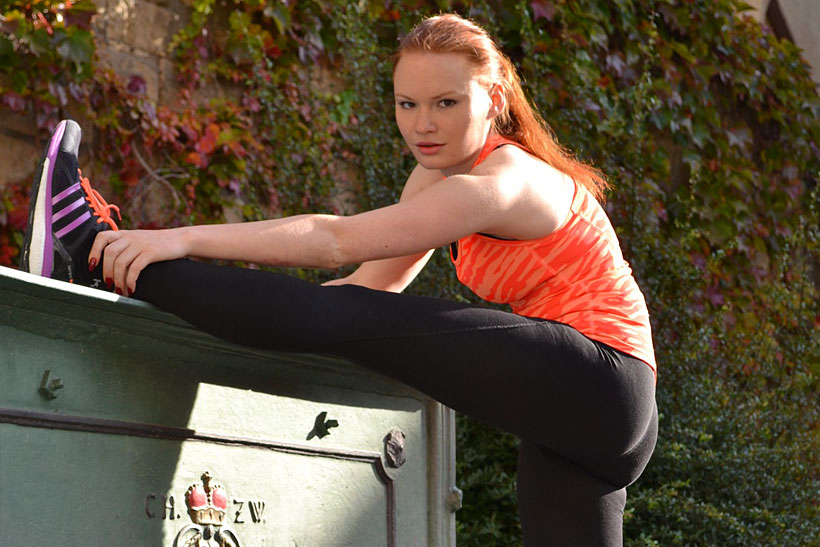 Congratulations! Just by clicking on this article, you’ve plowed through the first major obstacle in the way of your quest to get in better shape through running. You believe you can! And, you’re probably right!
Congratulations! Just by clicking on this article, you’ve plowed through the first major obstacle in the way of your quest to get in better shape through running. You believe you can! And, you’re probably right!
Whether you’re trying to get back in shape after an injury or after taking years off, or if running has never been your “cup of tea”, you most likely have the ability and power to overcome any reservations you have about lacing up the running shoes and hitting the roads and trails.
By taking things nice and easy and by following a few simple tips you’ll be well on your way toward finally understanding what they mean by the term, “runner’s high”.
1. Get the Green Light
While it’s true that even the most reluctant athletes can often train their bodies to accept a new running program, there are of course, a few exceptions. Certain health issues and lingering injuries may make running a bad idea. It is always best to check with your doctor before starting any new fitness routine to ensure that it’s the right choice for you and your body.
2. Invest in a Good Pair of Running Shoes
Once you get the green light from your doctor to start a running program, the first thing you should do is to invest in a good pair of running shoes. No matter how tempted you may be to purchase that cheap pair from your local discount store, avoid making this common and possibly disastrous mistake. At the same time, avoid purchasing the most expensive pair you find, too. Visit your local running specialty store and have an expert assess your foot shape and gait before recommending an appropriate shoe for you. Every runner is different, and a shoe that is appropriate for one runner, may not be for the next. Even if your recommended shoe type costs a few more dollars than another pair, buying the right shoe can be the difference between running success and costly doctor’s visits due to injury. Of all the tips for a new runner, this I without a doubt the most valuable. If you are making a true lifestyle change then this is a non-negotiable tip. Research on any good running blog and you will hear the same thing.
3. Dress Comfortably
Running clothing should fit comfortably, as to allow for free movement throughout your run. Clothing that is too loose or too tight will not allow for proper form. Plus, when your clothing is uncomfortable, you will also be far more likely to notice any other physical discomforts that should arise.
4. Set a Goal and Make a Plan
Whether it’s a race a few months down the road or a specific time you’re looking to finish that running route in, a goal can help keep you motivated and make it easier to stay on track. The best way to reach a new destination is to use a map to get there. Creating a plan to help you reach your goals will make it much easier for you to get there. Find a good beginner’s running program, put together an appropriate running schedule, and stick to it.
5. Don’t Be Afraid to Walk
Don’t fall into the trap of thinking that walking makes you less of a runner. When you’re first starting out, walking allows your body time to adapt to the physical strains that accompany running so that you stay healthy and are able to continue on your journey. Believe it or not, even marathon runners choose to walk from time to time.
6. Be Prepared for Aches and Pains
Any time you start a new fitness program, your body may need to go through an adjustment period when it will get used to its new demands. Minor muscle aches and pains are to be expected at first. To limit your discomfort, avoid running on consecutive days in the beginning so that muscles are allowed time to repair themselves. Ice can also be helpful in reducing the inflammation that can lead to soreness.
7. Reward Yourself
Once you start to make strides, it’s important to reward your accomplishments. Whether you buy yourself a new pair of running shorts or take yourself on a mini-vacation, by celebrating your successes, you will be much more likely to continue with a running program and will continue to see success.
8. Less is more
This may sound counter-intuitive, but I assure you that trying to do too much too fast will HURT! Running as with any other exercise requires periods of exertion and recovery in order for the body to adapt and become stronger. Well, unlike other activities running requires longer periods of recovery. While sorting through the multitude of plans and advice available on the web as well as through trial and error. The 80/20 rule is the best place to start. 80 percent of all your running should be at a low or very low intensity. Best advice is if you plan on incorporating running into your life, build up your base and DO NOT OVERTRAIN. Walking is perfectly fine.
If you are just getting into or recently started running, then you already know that it takes a while to build up the endurance to run for more than a short distance. (when I started, I could not run a 1/4 of a mile.) while you are building up that endurance there is absolutely nothing wrong with incorporating walking breaks into your training. In fact, it is one of the best ways to help build your endurance as a new runner. Provided the walking is at a brisk pace, your heart rate and breathing will be accelerated and therefore your body will be actively improving its aerobic conditioning. I am not sure where I first heard it but it rings very true.
“You go just as far running a 5-minute mile as you do running a 15-minute mile.” -Unknown
9. Develop a Mantra
In the beginning, I struggled with staying motivated. Truthfully, I still struggle with staying motivated. Let’s face it, it is hard to be motivated when you can only run for 30 seconds and then walk for 2 minutes. It can be hard to truly appreciate the small gains you make a day over day. don’t let this struggle get the better of you. Most people who stop running do so in the first week of trying. Appreciate the small gains and celebrate the improvements.
Even if you find that tomorrow you can jog for 3 seconds…celebrate the accomplishment. You earned it. If you begin to have negative thoughts and trust me EVERYONE has them from time to time, develop a mantra to push the thought from your mind while running. “I’ve got this”, “all walls have doors”, or my personal favorite and fallback, “today, define yourself.” Each are an example of good strong mantras.
My own experience suggests that you should avoid negative words in your Mantra. Avoid Don’t, Can’t, Won’t, etc. The subconscious is a powerful thing no need to feed it negative energy. Whenever you have a negative thought as you run, immediately start to repeat your mantra. Soon, you will be able to push the negative thoughts out as quickly as they appear and allow positive thoughts to replace them. This may be the most overlooked of the tips for new runners.
10. Enjoy the process…Because there are no shortcuts
I would love to tell you that after only a few short months I am running half-marathons and loving every minute of my newly developed and still growing running experience. The truth, however, is that I am just preparing for my first 5k and while I have come a very long way (from 1/4 mile before my first walk break on day 1 to about 4.5 miles before my first walk break after 4 months), it takes work and commitment to want to become better.
Final Thoughts-
There’s a reason why running is on of the most popular forms of cardiovascular exercise. Not only is running simple enough for almost anyone to do, it can be done almost anywhere, and best of all, it’s inexpensive! Beginning a new fitness program isn’t always easy, though, and it’s normal to hit some bumps along the way. Follow the tips below, however, and you’ll be running before you know it.
Benefits of Running That You May Not Know
Running is a favored pastime and chosen activity for weight loss. Everyone knows that running burns a lot of calories and improves endurance.
Many people start a running exercise program to prepare for a race, to get in shape or to maintain their health, but running provides additional benefits you may not have considered.
Here are what I consider to be some of the top hidden benefits of running. Enjoy!
The Top 5 Hidden Benefits of a Running for Exercise
1. Longevity
Running could extend your life. Research shows that engaging in cardiovascular exercise for 30 minutes or more on three to five days per week can help people live six years longer. Consider this anytime you are in need of motivation to get out and run.
2. Stress management
If you have never experienced a running high, you are in for a treat. Running stimulates the release of brain chemicals such as dopamine, serotonin and norepinephrine that enhance your mood. Not only will you feel better as you run, your “high” can last up to a day afterward. Following a running exercise program provides a regular boost to your mood.
Running is also a great way to forget about stressors in your life. The exertion brings you into the moment, giving your mind a break from worrying about things or feeling negative emotions such as disappointment, loneliness or sadness. By the time you are done, you should be sweaty and red-faced, but oddly happy and serene.
3. Boosts Brain Function
Running may actually improve your memory and spatial awareness. Research shows that the part of your brain called the hippocampus is most affected by running. This area is related to memory and learning. A study on mice found that those who voluntarily ran on their wheels experienced an increase in brain cells and did better on tests for spatial learning. Spatial learning allows you to navigate through unfamiliar territory and be aware of where objects are in the new space.
4. After Burn
Running utilizes calories while you do it, but it also causes you to burn extra calories afterward. The average person burns around 470 to 650 calories in 60 minutes when running at 5 mph. Yet for every 100 calories you burn on a run, you can expect to burn another 15 calories post workout.
5. The Power of Sunlight
Most people who follow a running exercise program prefer to be outdoors. Running outside during the day is not only safer because cars can see you, but it also gives your skin the chance to soak up the sun. Your skin makes vitamin D when exposed to sunlight. How much it makes depends upon the strength of the sun and the color of your skin, plus how much skin you expose. A fair skinned person running at midday gets around 10,000 international units of vitamin 10 in only 10 minutes, if wearing shorts and a tank top but no sunscreen.
People with low vitamin D levels are more than twice as likely to die from heart disease, according to a study published in the Archives of Internal Medicine. Researchers stated that less time outdoors is a main reason people could have low vitamin D levels. Spending time outdoors also fights seasonal affective disorder and may reduce anxiety and stress.
Final Thoughts
In many ways, running makes you feel better mentally and emotionally. Consider these top 5 hidden benefits of a running exercise program if you are on the fence about getting started.
Five Things You Should Be Doing After Every Run
 Running is one of the most efficient physical exercises for staying in shape, but many runners eventually struggle with injuries related to the impact sustained by their joints. Overuse injuries are common (and can prevent you from running entirely), but they can be prevented if you learn to take proper care of yourself before, and especially after a run.
Running is one of the most efficient physical exercises for staying in shape, but many runners eventually struggle with injuries related to the impact sustained by their joints. Overuse injuries are common (and can prevent you from running entirely), but they can be prevented if you learn to take proper care of yourself before, and especially after a run.
What to Do After a Run: Five Steps
Whenever you’re done with a run, use these five practices to significantly reduce your chances of injury, improve your body’s capabilities, and improve your performance on subsequent runs:
- Cool down. Before you head inside or go back home, make sure to cool down. Continue your workout session at a lower level of intensity, so you can gradually acclimate your body to be at rest. It’s a good way to catch your breath and keep your muscles warm, while relieving the tension they receive during heavy exercise. If you’re running, a brisk walk or light jog would be an appropriate way to cool down.
- Tend to your dry or damaged feet. Running can take its toll on your feet, especially if you’re going heavy distances. Take off your shoes when you can and take care of your feet as soon as possible. That could mean tending to blisters, fungal nails and trying a foot renewal product to improve the appearance of your feet.
- Stretch your muscles. Next, take the time to stretch all the muscles in your lower body (and your upper body, while you’re at it). Slow, progressive, deep stretches will help relieve some of the lactic acid that builds up in your muscles during exercise. More importantly, it will keep all your tendons, ligaments, and muscles elongated, flexible, and loose; that way, you’ll be less susceptible to injuries in future runs.
- Log your time and distance. Take a moment to log the distance you ran and how long it took you. If you use a running app, this may be done on your behalf automatically. If not, write it down in a notebook. This is a good way to keep track of your progress toward your goals, as well as a way to ensure you aren’t scaling up too quickly. It’s important to build distance and speed gradually, so you don’t injure yourself as you improve.
- Refuel. Part of being successful as a runner is paying attention to your nutritional intake. After every run, drink plenty of water so you can rehydrate. Depending on the distance you traveled and how much you sweat on the run, you may also need to replenish your electrolytes. It’s helpful to eat at least some simple carbohydrates so you can restore your muscles’ glycogen, and a suitable amount of protein so your body can begin to recover.
Other Important Strategies to Keep in Mind
Post-run strategies aren’t the only things that stand between you and the possibility of injury or inefficiency. These strategies can also improve your health and the sustainability of your running initiative:
- Pre-run strategies. Post-run strategies are great, but you’ll also need to consider pre-run strategies. Before you go on a run, take the time to warm up with a light jog or a quick walk around the block. It’s also a good idea to eat and drink enough to keep you going on your run; simple carbohydrates (like those in fruit) are a good choice, and make sure you have a way to rehydrate during your run. Think carefully about how you want to scale your running distance too. Running too much or too quickly will almost always result in injury. You can follow a running training program online, or devise one on your own, but either way, make sure you’re not increasing your total distance by more than 10 percent per week.
- Cross-training. Cross-training is important to make sure every area of your body gets some physical exercise, and it can help you condition some complementary parts of your body so running is less likely to lead to injury. For example, you could take up cycling to substitute for running on occasion or use swimming and lifting to fill in other days of the week.
- Equipment replacement. It’s also important to pay attention to the condition and quality of your equipment. Depending on how much you run, you’ll probably want to replace your running shoes once every season. Good, fresh running shoes are one of the best ways to prevent injury.
Running has a high impact, and can lead to injuries, but it doesn’t have to. Pay close attention to your body and your running regimen, and be proactive in managing your progress. The more sustainable your training approach is, the more successful you’ll be.
Can Walking Act as Your Exercise Routine?

When it comes to your exercise routine, thoughts of lifting weights, taking cardio-based classes, and really pushing your body to the limits often come to mind. But what about walking? Can walking alone act as your exercise routine? Is walking enough to provide the health benefits and even weight loss or maintenance that you’re looking for?
Gaining the Status of “Exercise”
Typically, when you think of walking, you think of it as a means to get from point A to point B, but it may just be time to change how you view it. Walking can also act as a wonderful way to workout. It was back in 1989 that a study was done on brisk walking at the Cooper Institute. The study found that walking was indeed a form of exercise. The study showed that those considered moderately fit were much less likely to die due to heart disease versus those people who didn’t get up and get moving.
Thanks to a recent study, the U.S. surgeon endorsed walking as a form of exercise and started to encourage people to take part in at least 30 minutes of physical activity at a moderate pace, such as walking, each and every day. The American Heart Association also endorses walking and suggests that same 30 minutes per day guideline.
“A sedentary lifestyle can be deadly,” concurs Paramus, NJ plastic surgeon Dr. Gary Breslow. “Extended periods of physical inactivity raise your risk of developing heart disease and obesity, among other serious medical conditions. Low-impact exercise is a free, effective way of combatting that risk.”
And while you may not necessarily think of walking as a big calorie burner, depending on how fast you walk, you can burn between 90-200 calories in that half hour. When you are doing that each and every day, that can certainly help you maintain a healthy weight. If you’re looking to lose weight, then you can increase the amount of time you walk and make sure you’re walking at a brisk pace. As well, the less fit you are, and the more you weigh, the more calories you will burn in a week.
In other words, you could start to see some significant results on the scale simply by walking.
Health Benefits of Walking
Now that we’ve looked at the benefits on the scale, what about the other health benefits walking offers? Walking is one of the very best things you can do for your heart health. It works to strengthen your heart, which in turn will reduce your risk of stroke or heart disease.
Other fabulous health benefits include the fact it reduces your risk of developing certain diseases such as, gastrointestinal disorders, irregular bowel movements, colon cancer, and type 2 diabetes. It is an instant energy boost and a mood booster, and if you’re walking outdoors it will give you a dose of much-needed vitamin D, and it will help to tone up your body.
Great on Its Own or With Other Activities
When it comes down to it, walking is a fabulous form of exercise, whether you choose to do it on its own or combine it with other exercises. Perhaps the best part about incorporating walks in your exercise routine is the fact that it doesn’t usually tire you out enough to interfere with your sessions at the gym.
It Makes the Brain Work with More Clarity
It has been proven that the brain tends to work better on the move, which means that 30-minute walk you had started taking recently will probably make you more creative and you will likely solve problems faster. In fact, it is suggested that if you are stuck trying to find a solution or if you can’t remember something important for a while, just take a walk and you will probably be able to think much more clearly and in a focused manner.
Legs Look Better When We Walk Regularly
Lifting weights may make your veins pop in a good way, but as we age, a different and unwanted type of vein structure begins to become more visible and they are known as varicose veins. These are not nice to look at and may even cause restlessness in some cases. Walking actively prevents varicose veins from appearing by keeping the secondary blood circulation system located in our feet and calves active and healthy. Even if you already have visible varicose veins, walking regularly can make them less visible.
Psychological Benefits Galore
As mentioned previously, regular walking can improve our mood, but there are various other psychological benefits associated with walking as well. Studies show that a person leading a sedentary lifestyle gains confidence after just a few days of regular walking. Senior citizens and people who are unable to participate in most other forms of exercise due to health conditions often find regular walking to be exactly what they needed, both physically and mentally.
It’s Good Cardio
Many of us love hitting the weights but hate the treadmill at the gym and walking is the perfectly solution in such cases. Replace the treadmill sessions with long walks through the local park to see better results. This has multiple benefits and they are as follows:
- You will still have enough energy left for your weight training sessions at the gym
- You will probably lose more fat on the treadmill, because skipping walks are rarer as compared to skipping the bike or the treadmill
As you might have already concluded from the points above, walking can indeed act as your exercise routine, but it has to be a regular part of your life. Also, we are not talking about a 5 minute stroll either, because the walk needs to preferably last at least for 30-minutes. You don’t have to powerwalk all the time but you can do so for a few minutes if you can.
Starting a Treadmill Workout Program
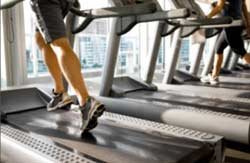
Regardless of whether you are just starting your first exercise program, have been exercising regularly for a while, or are a competitive athlete, it is important to know some simple, yet crucial aspects of starting a treadmill workout program. You can have a workout program using a treadmill exclusively, or use it to cross train with other forms of exercise. Let’s take a look at some of the things you need to do before getting started.
Before Starting a Treadmill Workout
Prior to getting on the treadmill there are a few things you can do to ensure a safe, effective and comfortable workout. First off, make sure you wear under garments and clothes that are comfortable to prevent chafing and other wardrobe malfunctions that could negatively affect your workout. Dress appropriately for the temperature of the room or risk lowering your workout efficiency.
Proper running shoes are another important aspect of your attire. Optimal running for you may require motion control shoes so make sure you talk to a professional about your gait before starting a treadmill workout program. At the very least a good pair of running shoes should do the trick.
Make sure you bring a bottle of water or your favorite sports drink as well to replenish the water you lose in your sweat. Last but not least, if you plan to listen to music, make sure you have your music player set up properly so it does not interfere with your workout in any way.
Tips to Start Your Treadmill Workout
Stand on the treadmill belt before you start the program. Enter all your information (some treadmills may ask for age, weight, height, etc.) including the program you wish to use. Even though warm-ups are often included in the treadmill console workout programs, you may wish to use the ‘quick start’ feature and get a few extra minutes of low intensity walking in to loosen up.
After your warm-up it is time to begin the primary workout. You can set the speed and incline to your desire or use a program to change the incline and determine workout intensity. Remember, as with all cardio exercises, your heart rate is the determining factor of your exercise intensity. At first, try to use a level of a program that you know you can easily complete. This will allow you to make consistent progress each and every treadmill workout.
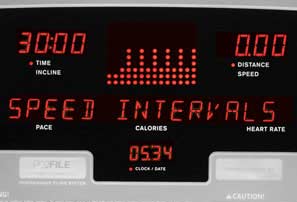
Programs on treadmills usually control the incline to modify the intensity, leaving the speed adjustments up to you. Other programs modify the intensity (incline) based on your heart rate. These heart rate programs are best used with a wireless heart rate monitor as holding on to the handles for the duration of the workout is not desirable.
Benefits of Using a Set Program
- Burn more calories on average
- Set a baseline in which to progress from
- Get more accurate calorie readout
- More options for changing up workouts
How to make the Most out of your time on the Treadmill
When it comes to exercising on treadmills there are essentially 2 types of people; Those who like to run/jog and those who don’t like to run/jog. The good news is you can burn just as many calories walking (at an incline) as you can sprinting (on a flat surface) on treadmills. If you don’t like running or jogging on treadmills, simply set a high incline and walk at a brisk pace. For example, walking at 3.5 miles per hour on a 15% incline will burn just as many calories as sprinting 8 miles per hour on a flat surface {not exact figures, just to show example}.
If you decide to take the walking at an incline approach when you’re starting a treadmill workout make sure you DO NOT support your weight with the handle bar. Holding treadmill handles defeats the purpose of the incline and has other negatives. You can use the handlebars for the heart rate monitors or for balance and safety but don’t use them to pull your body weight up.
Five Workouts One Can Do on a Treadmill
Physical activity is the key to a healthy and active lifestyle. However, in the busy world, we live in it can be difficult finding time for a gym or jogging every day. Not to worry, there is a perfect solution: a treadmill. It is a great exercise machine that will become efficient cardio. Find out five different workouts you can have using a treadmill.
1. Treadmill Hill Workout
Modern treadmills like NordicTrack c 990 have many modes. It is a great advantage as doing the same exercise daily can be boring. One of the main treadmill exercises is a hill workout. It means that you will be running not on a flat surface but a hill. Of course, it can be very difficult at first. That is why we recommend gradually increasing the incline so that you are comfortable. It is also best to keep the speed moderate, especially for beginners.
Treadmill hill workout is a great way of cardio. Not only you will burn more calories compared with regular jogging, but you will also improve your stamina and body strength. Professionals also recommend trying intervals of speed and recovery. It means that you will increase the speed and run fast for some time, for example, 1 minute, and then recover by walking slowly for 30 seconds. The intervals depend on your skills and experience.
2. Treadmill Hiking Workout
The next way of working out with the treadmill is hiking. First of all, you will need to determine the time of one session. It is usually 25 or 40 minutes. The main principle is that the focus is on the backside. Moreover, the incline will increase gradually during the workout. As for the speed, it is not obligatory to change it. It should just correspond to your skills. You should start your session by warming up for five minutes. Then start increasing the incline. It should not be a problem with good machines where you can raise the incline up to 40%.
3. Sidewinder Workout
As indicated in the name, the objective of this treadmill workout is to improve your skills of coordination. This exercise will be great for your stamina, duration, and stability. First of all, you should spend a couple of minutes warming up. The main purpose of the workout is to alternate side and straight walking. For example, you can start with side walking for 2 minutes on the right side, then two on the left. After that, walk regularly for a minute and repeat the cycle again. Nevertheless, we should warn you: if you have problems with coordination, it is better to avoid this exercise. It is very easy to fall and obtain an injury.
4. Treadmill Workout with Weights
People traditionally believe that you can only do cardio on treadmills. It is not entirely true. If you want to improve your upper-body skills and add something new to regular running, this exercise is for you. You should take a couple of dumbbells and hold them in your hands during the exercise. Mind that it is better to go for weight no more than 3 pounds. Moreover, the duration of the workout should be no more than 20 minutes. Mind that this workout will be much more difficult than regular jogging.
5. Sprint Interval Workout
Last, but not least exercise you can do on modern treadmills from jonsguide is sprint workout. It is a great way of burning calories fast. The main idea is to increase the speed drastically for a short period and then repeat the cycle several times. If you are a fan of pushing your body limits and trying something new, a sprint interval workout is a perfect choice.
See Also:
- Top 5 Things to do Before and After Your Run
- Running to Lose Weight
- Top 5 Hidden Benefits of a Running Exercise Program
Starting a Weight Loss Running Program
Embarking on a weight loss running program is the best approach for losing those pounds and keeping them off for good. According to many studies, running burns mad calories, boosts metabolism levels, prevents cardiovascular problems, and will help you get into the best shape of your life. Not only that, the sport’s inclusiveness is part of its appeal; all you need is a couple of decent shoes and off you go!
Therefore, if you’re looking to shed some pounds, here are a few running beginner’s guidelines that can help you achieve your weight loss goals without risking injury or disappointment.
Key Weight Loss Tips & Recommendations for Runners
Set Goals
First of all you need to set goals. Clear and measurable goal pave the way toward greater fitness results. If you don’t set a target to aim for, then you’ll definitely get either bored, confused or both, which can spell disaster on your new fitness resolution. Therefore, before you head out of the door, grab a piece of decide on your goals. Choose a realistic goal which will allow to gradually build your fitness foundation.
Expect Discomfort
First-run horror scenarios are prevalent, but avoidable. In fact, if you’re a new comer to the sport of running, then expect discomfort during the run and some muscle soreness and fatigue afterwards. Nevertheless, you could curb the pain and post-run agony by taking ample walking breaks and keeping your running pace slow. In other words, you need to follow the walk-run-walk program
Walk-Run-Walk
The walk-run-walk training recipe is the ideal training approach for increasing cardio power without running the risk of injury or overtraining syndrome. This training method lets you control your breath and protects your muscles and joints from any unnecessary damage. As a beginner, you need to adjust the length and intensity of each interval according to your own needs and training goals. Start off with a 30-second run, interspersed with one-minute walking for recovery. And as you get stronger, aim to increase the time spent running and take less for recovery.
Eat Right
 The mechanics of weight loss are no secret. It’s all about creating an energy deficit, meaning that you burn off more calories than you take it. That’s it. But when it comes to keeping your body on the run, proper fuel is critical for weight loss and performance. Therefore, you should never sacrifice performance for weight loss as doing so can spell disaster on your weight loss efforts and over-all health levels.
The mechanics of weight loss are no secret. It’s all about creating an energy deficit, meaning that you burn off more calories than you take it. That’s it. But when it comes to keeping your body on the run, proper fuel is critical for weight loss and performance. Therefore, you should never sacrifice performance for weight loss as doing so can spell disaster on your weight loss efforts and over-all health levels.
To make sure you’re keeping your body well fueled while dropping the pounds, do the following:
- Timing is key. Keeping your body well fueled is matter of when. Pre-run meals should be eaten 2 to 3 hours prior to the workout to allow your body time to digest and absorb the energy. During the recovery window – the hour following a run – aim for a combination of carbohydrates and protein to replenish lost energy and boost muscle repair.
- Eat your protein. Protein is key to muscle repair and proper recovery, but according to a joint study by the Cambridge University and the University Of Sydney, eating protein with every meal suppressed appetite and helps you ward off unhealthy snacking. The researchers found that the subjects who ate a daily diet consisting of 15 percent of protein consumed 1036 less calories over four days than those whose diet was 10 percent protein.
- Keep track. Using a food diary on a daily basis helps you highlight problem areas in your daily intake. For the most of the time, it’s those unconscious eating habits – such as excess beer or late night snacking – that keeps the pounds piling on.
- Eat the good fats. Fats have a bad reputation in the fitness circles. But they’re not all created equal. What you need to avoid are the bad fats – saturated animal fats found in butter, cheese and dairy products. On the other hand, make sure to eat plenty of the good fats – mainly found in nuts, plants, oily fish and sunflower.
Final Thoughts
The golden key to success in all areas of life is speed of implementation. Though the above guidelines are effective, what you do next is what matters most. It’s only by taking action, on a consistent basis, that you’ll start achieving your desired weight loss results.
Knee Pain Causes & Prevention Tips For Runners

Throughout my running career, I’ve endured anyone’s fair share of injuries. Knee pain is the most annoying of them all, and it has kept me on the bench for more than once. That’s how I learned that I should never take running for granted and I should perform the necessary actions to prevent knee pain as much as possible.
What hurts the knees?
The answer varies from runner to runner. It may be caused by the back, hip and the sciatic nerve. In some cases, it’s all about running too much or taking up a challenge before you’re body is fit enough. Sometimes the reason resides in the high number of strides. This usually takes time to convert into knee pain, but when it does, it’s totally unpleasant.
What can be said with certainty is that reasons are somehow split in two. It’s either a physical issue or a training habit that may lead you to that dragging knee pain.
What kind of knee pain is there?
Here are a few types of pain you are prone to endure. If you’re feeling some kind of stiffness over the front or inner side of the kneecap and if the pain increases as you decline, but still it fades away a few minutes after you’ve started running, you may have Patellofemoral pain. What you should do is decrease distance and intensity, and also avoid running up the hills.
Next, there is the Iliotibial band syndrome that is quite easy to identify: when the outside of your knee is stiff, tender or aches. This is mostly common among those who run on the track on a regular basis, usually training for marathons. What you can do is take anti-inflammatory with 1 or 2 hours prior to your run and stretch before and after the run. Of course, you should reduce the number of miles and the intensity level too.
Patellar tendonitis is an awful type of knee pain. It actually represents an inflammation of the joint tendons when tissue regrowth is slower than tissue damage. The highest incidence occurs among runners who increase mileage, who run downhill or increase pace. It usually manifests through a pain below the kneecap and gets worse during running.
An ACL injury or tear is another cause of debilitating knee pain that many runners will experience. Unfortunately the ACL doesn’t always heal well on its own when injured, which often leads to an unstable knee that will cause knee pain and increase your risk of injury when running or performing simple daily tasks such as crouching or walking up stairs. An ACL tear will more often than not require ACL reconstruction surgery. See your doctor right away if you suspect you’ve injured your ACL. ACL injuries may be accompanied by meniscus or articular cartilage damage or lead to further knee problems down the road if left unchecked.
There is one more type of pain that you need to be aware of, the awful osteoarthritis. It is as bad as it sounds. It represents the tear of the cartilage, but you can still engage in moderate walks and runs. What you must do is reduce the number of miles and the pace when symptoms occur: swollen knee and a nasty ache below the kneecap.
Recent studies have shown that running actually keeps down the risk of joint degradation or osteoarthritis. Yet, if you suffer from it, you must pay extra attention to your training intensity.
What can you do to prevent knee pain?
 Since knee pain is a nasty feeling every runner experienced at some point, specialists thought of creating something that is easy to use, comfortable and greatly efficient. Maybe you’ve heard by now about the knee tape, which is an athletic adhesive that absorbs most of the stress on the patellar tendon. What this tape does is accelerate healing, without interfering with your range of motion. The mechanics are simple: the tape pulls the skin up, this way enabling blood flow to the damaged part of your knee.
Since knee pain is a nasty feeling every runner experienced at some point, specialists thought of creating something that is easy to use, comfortable and greatly efficient. Maybe you’ve heard by now about the knee tape, which is an athletic adhesive that absorbs most of the stress on the patellar tendon. What this tape does is accelerate healing, without interfering with your range of motion. The mechanics are simple: the tape pulls the skin up, this way enabling blood flow to the damaged part of your knee.
It’s recommended that someone shows you how to put it on, there are details you must consider when applying it. Once it’s on, it will last for up to 5 days. Yes, you can take as many showers as you want. You may want to opt for the black one, it looks cool even with dribbling sweat. I’ve tried it and it has been efficient.
Other measures you can take are strength training, wear a knee brace, wear an orthotic, definitely wear running shoes for your foot type, replace worn shoes, rotate laps when running on a track, put some ice on, cross train, stretch before and after workout, strengthen the joints and leg muscles, focus on quads, shins and gluteals and also take nutritional supplements.
Another aspect that many runners tend to obliterate is the ankles. Ankles have a major role in preventing knee pain. As ankles gain mobility, knees are more able to absorb force properly. Don’t worry, ankle issues are easy to fix. All you need is to maintain a certain warm-up routine, specifically designed for stronger ankles.
I know you won’t like me saying this, but when you feel like there’s too much pressure on the knees and the pain does not disappear after 1-2 days of rest, stop. Maybe you’re running the marathon, maybe you’re so close to your target, maybe you’re just too stubborn. Don’t be. Just stop and visit a doctor if the pain persists.
Running is great, but knee pain can be a mischief. My advice to you is to keep your eyes open for any symptom that may arise. If you do something to cure the pain as soon as it kicks in, the job is half done.
Knee Pain Causes and Prevention Tips For Runners: References
1. Cymet, T.C., and V. Sinkov. Does long-distance running cause osteoarthritis? Journal of the American Osteopathic Association, 2006.
2. Beth Dreher, Runner’s World Magazine, Tape Yourself: Runner’s Knee, February 2009 issue
See Also:
How to Deal with Hip Pain While Running
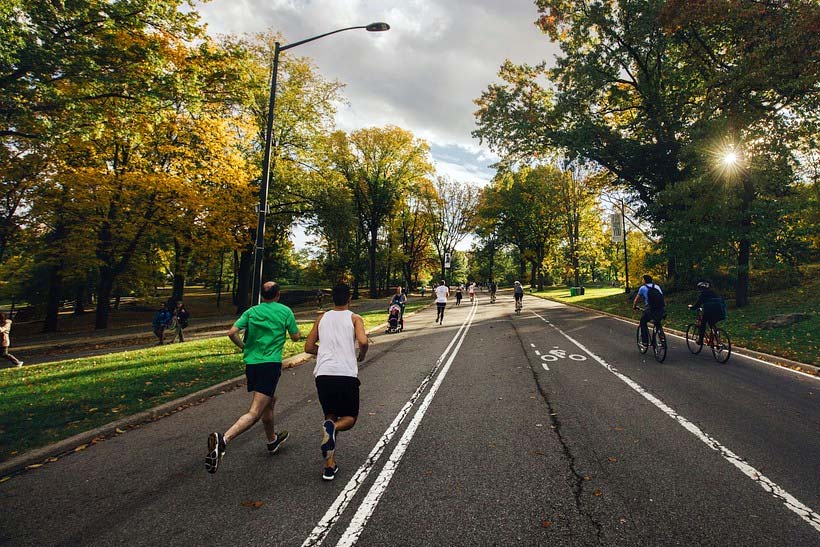 Running is an activity which promotes great health and clarity of mind, but neither of those benefits can be attained if your joints are pained after or during a run. One of the most common joint pains experienced while running is hip pain.
Running is an activity which promotes great health and clarity of mind, but neither of those benefits can be attained if your joints are pained after or during a run. One of the most common joint pains experienced while running is hip pain.
Hip pain can be caused by several things. One potential cause for premature osteoarthritis could be excessive running. Luckily for us, there are also several things which can help with softening and stopping pain associated with hips while running. If you experience hip pain running, there are some things you should know.
Hip Pain Causes
Hip pain while running can be caused by any or several of the following:
- Inflammation
- Minor Tears in Cartilage
- Alignment Issues
- Injury
- Strain or Tendinitis
Many of these causes for hip pain and discomfort are made worse or caused by running regularly. Just because these can be aggravated by the activity doesn’t mean you need to give up your favorite exercise.
Treatments and Tips
Instead of calling it quits and throwing away your running shoes, here are some things you can do to slowly alleviate hip pain from running so you can get back into it.
Inflammation
If you experience inflammation in your hips, which is often diagnosable by a doctor, you may feel painful tightness or swelling from knees to hips or around the inside or outside of hips. This can be helped by taking regular anti-inflammatory supplements and giving legs time to rest.
Minor Tears in Cartilage
If you have small tears or tips in the cartilage surrounding your hip joints, this could be caused by misalignment of the pelvis, and it can be made worse by regular running without being treated. One way to help with this is by taking time to stretch gently before, during, and after running.
You could also incorporate hyaluronic-acid-rich foods, proteins, and supplements into your diet, and make sure you are getting a regular collagen protein intake.
Alignment Issues
If you feel your hip pain while running is caused because of poor posture habits, general spine issues, or other alignment imperfections, a visit to the chiropractor can reap great benefits on hip alignment and joint health.
Injury
Past injuries can affect future performance in running to a high degree. Even if it has healed completely, the area may be weaker or thinner, and friction in the hip area may irritate the scarred tissue and cause hip pain.
Ways to help with injury-related chronic pain in the hips include yoga, taking supplements and medicine, regular physical therapy check-ups, and chiropractic appointments.
Strain or Tendinitis
Overworking the hip joints can cause intense strain leading to inflammation and tendinitis in these areas of the body. While rest and general care may be appropriate steps, another way of expediting the recovery and long-term care process is by taking supplements like PerformaFlex™, which is a fantastic joint health formula to care for hips and other joints.
The Bottom Line
Strain, injury, misalignment, and many other things can contribute to hip pain while running, but proper care, hip pain exercises, and medicinal supplements can combine to provide long-term relief.
Runners Guide for People with Abnormal Feet
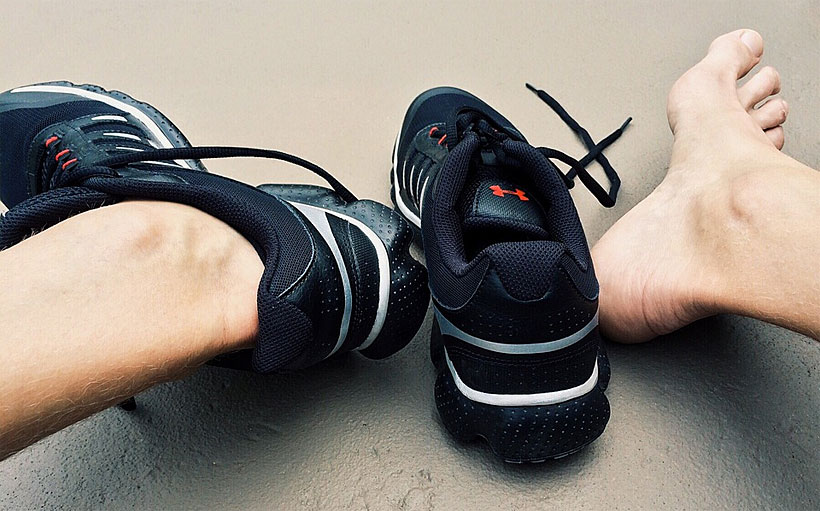 Before you start thinking that you’re the odd one out, we need to remember that roughly 60% of the world’s population has some sort of foot abnormality. Flat-feet, supination, bunions and plantar fasciitis are some of the ailments that people live with. Wide feet is also among the abnormalities that people face and it’s the most common.
Before you start thinking that you’re the odd one out, we need to remember that roughly 60% of the world’s population has some sort of foot abnormality. Flat-feet, supination, bunions and plantar fasciitis are some of the ailments that people live with. Wide feet is also among the abnormalities that people face and it’s the most common.
Runners who have wide feet may experience increased foot fatigue if you’re not wearing proper footwear and research indicates that wearing shoes that are too tight can lead to bunions or further widening of the forefoot.
The most important piece of the puzzle for runners with wide feet are the shoes they wear. You can’t replace your feet (unfortunately) but you can pick good wide feet running shoes without having to endure the pinching and uncomfortable feeling of ill-fitting shoes.
Wide Shoes for Wide Feet: Key Tips
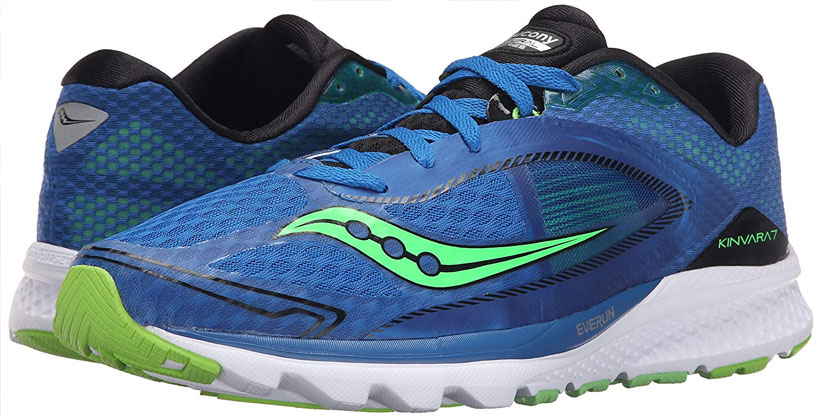 Running is perhaps the best (and most natural) workout there is and it can have various physical and psychological benefits. It is for this reason that your first order of business should be to get the width of your feet measured. If you have low or high arches, you can generally find out by wetting your feet and pressing it against a paper towel to find out if you’re a pronator or supinator.
Running is perhaps the best (and most natural) workout there is and it can have various physical and psychological benefits. It is for this reason that your first order of business should be to get the width of your feet measured. If you have low or high arches, you can generally find out by wetting your feet and pressing it against a paper towel to find out if you’re a pronator or supinator.
There are many other factors to consider when buying wide running shoes – the width being just one of them. The other factors to consider is the quality of the outsole depending on what kind of terrain you run on. Trail running shoes have more aggressive tread patterns while road-running shoes appear low-profile. Some outsoles are supplied by tire manufacturers and help with running under any condition – wet or dry.
Shoe Buying Tips for Runners with Abnormal Feet
Other things to consider in a running shoe is the upper material – which is very important for breathability. Knit and fabric uppers are very good with ventilation but often lack in durability. Synthetic upper on the other hand is highly durable but lack breathability. Picking the right kind of upper material will prevent sweaty and smelly feet.
Try Before You Buy
Make sure to try on shoes before you buy them. As a general rule of thumb, your shoes should neither be too tight nor too loose. A tight fit will cause aches and pain, while a loose shoe will have your feet scrapping on the inside causing blisters and rashes. The ideal size is one that fits snugly (like a glove) and comfortably.
Wear Before Your First Run
It is also recommended to wear your newly bought shoes inside the house to get a feel for it before taking it out for a run. If things still don’t feel right, you can always return it for another pair that way. A lot of shoe manufacturers and retailers (including online ones like Amazon) have a generous return policy as long as the shoe hasn’t been worn outside.
Consider Orthotics or Motion-Control Shoes
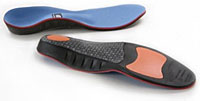 If you have any sort of foot abnormality, be sure to visit your doctor for a consultation on what best suits your needs. The doctor might recommend an orthotics insole in addition to your footwear to help you with your gait and posture. Most shoes have removable insoles and this is where you can swap out the standard shoe insoles for an after-market one.
If you have any sort of foot abnormality, be sure to visit your doctor for a consultation on what best suits your needs. The doctor might recommend an orthotics insole in addition to your footwear to help you with your gait and posture. Most shoes have removable insoles and this is where you can swap out the standard shoe insoles for an after-market one.
If you have flat-feet, also known as overpronation, you should really consider investing in motion-control shoes that will negate the effects of overpronation while running. Supinators (people with high arches) on the other hand can get by with neutral running shoes with extra cushioning to help with their gait.
Exercise, Stretching & Self-Care Tips
In addition to wearing the proper footwear, it’s important to consider your self-care to prevent injury and improve recovery time. This includes stretching, cooling down, and hydrating.
Stretching
It is also important to do some foot stretches before running to make sure you avoid injuries and maximize your workout. Simple exercises like the toe stretch or the foot roll don’t take much time or space to be done effectively. You can couple this with more stretches that can be done post-running to relax your quads and calves.
Cooling Down
Cooldown before and after a run with a 5-minute walk and don’t forget your music selection because good beats can help you push that extra mile. I never leave for a run without my Jaybird X3 water-resistant earphones. There are other good offerings from Bose, Apple, and Anker when it comes to sports wireless earphones that are perfectly suited for any type of runner.
Hydration
Finally, always remember to keep hydrated as it will not only increase your mileage but also help flush toxins out of your system. Try to avoid plastic bottles and instead buy reusable water bottles (made from stainless steel) or even hydration bladders depending on your running needs. And avoid flavored water with tons of added sugar and instead stick to plain water.
The Bottom Line
With the proper footwear and self-care, running doesn’t have to be a pain in the feet, even if yours are “abnormal.” Have fun and keep running!
Tips For Choosing The Perfect Running Shoes
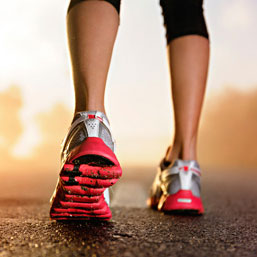 Anyone who runs competitively will tell you that the right shoes can make a tremendous difference in everything from your speed to your endurance. Regardless of whether you are training for an upcoming race or are just running for fun, choosing the right pair of shoes is essential.
Anyone who runs competitively will tell you that the right shoes can make a tremendous difference in everything from your speed to your endurance. Regardless of whether you are training for an upcoming race or are just running for fun, choosing the right pair of shoes is essential.
Shoes that don’t fit correctly or that are improperly designed not only make it more difficult to run but they also increase the likelihood of injuries occurring. When your feet are not properly supported, muscular strain increases, leaving you feeling even more sore than usual.
Five Tips to Help You Choose the Perfect Running Shoes
The hard part is knowing which shoes to buy. With so many different pairs on the market, choosing the right shoes is challenging. Try using the tips and information below to find the ideal pair for your feet:
#1. Regularly Replace Your Shoes
One of the biggest mistakes that people make with their running shoes is failing to replace them often enough. Most experts recommend replacing your shoes after running about 500 miles in them. If you run regularly, that means that you may need to buy new shoes every few months. Think about how far you run each day and how old your shoes are to decide whether or not you need a new pair.
#2. Check Your Arch
The way that your foot strikes the ground plays a key role in determining which shoes are best. To get a better understanding of your feet, there is a simple test that you can perform. This test is designed to identify the height of your arch.
To begin with, place a brown paper bag on the ground. Make sure that it is large enough for you to stand on without your feet hanging off the edges. Next, get your feet wet and step onto the paper. After a moment, step off again and evaluate the footprints that you left behind.
If you have normal arches, you should see a curve that connects the heel area with the toes. The width of this curve should be approximately half of the entire width of your foot. If the curve is narrower or if it is broken, it usually indicates that you have high arches. On the other hand, if the line is relatively straight and it doesn’t really vary in width, you probably have low arches.
#3. Educate Yourself About Pronation
When you run, the shape of your foot causes it to move in a very specific way. When your foot strikes the ground, it rolls in one direction or the other, based on whether you have high arches, normal arches, or flat feet. This rolling motion is known as pronation. When shopping for shoes, it is important to choose shoes that are designed to properly support your feet, based on the height of your arch. Proper support will help ensure that you don’t over- or under-pronate.
If you have high arches, you most likely under-pronate. This means that the majority of your weight lands on the outer portion of your foot, simply because the inside of your foot lacks support. If you have low arches or flat feet, on the other hand, you most likely over-pronate. That means that your feet have a tendency to roll to the inside. People with regular arches generally don’t have problems with over- or under-pronation.
#4. Thoroughly Test Shoes Before Buying Them
When shopping for running shoes, it is extremely important to try them on. You need to feel how they fit before you can decide whether or not they are right for your feet.
If you are shopping at a shoe store, check to see if they have a treadmill on hand that you can use to test out the shoes. If not, walk around the outer perimeter of the store or jump around in place to make sure that the shoes fit correctly and feel good on your feet.
#5. Use A Separate Pair Of Shoes For Racing
If you are going to be participating in races, you should purchase shoes that are specifically designed for racing. These shoes tend to be a lot lighter weight than traditional running shoes. For training, however, you should use regular running shoes since they provide extra support. If you wear your racing shoes every time you train, you are more likely to experience injuries since they don’t offer as much support.
A Step-By-Step Guide To Buying Running Shoes
#1. Avoid being in a hurry when you are shopping for shoes. Choosing the wrong shoes can cause serious injuries like stress fractures. It is best to take your time to avoid making the wrong decision.
#2. Shop at stores that specialize in running shoes. Anyone who assists you should be knowledgeable about running shoes or should be a runner themselves.
#3. Shop in the afternoon or evening. Feet tend to swell throughout the day. Shopping later in the day helps ensure that your shoes won’t become too tight because of this swelling.
#4. Bring your previous pair of running shoes with you to the store. That way, the staff can evaluate the tread to determine how your feet move when you run.
#5. Dress for shoe shopping. Consider wearing athletic clothing since many shoe stores now have treadmills on hand that you can use to test out the shoes.
#6. Wear the same socks that you plan on running in. If you use shoe inserts, you should also bring them with you.
#7. Avoid buying shoes that feel uncomfortable when you try them on. If they don’t feel good in the store, they won’t feel good when you are running in them, either.
#8. Don’t get too hung up on buying a particular style or on purchasing a specific brand. Explore all of your options to see which shoes are the most comfortable and supportive.
#9. Even if a friend recommended a specific pair of running shoes, you should shop for shoes based on your needs. Their running style may not be the same as your own.
#10. Don’t skimp. A high-quality pair of shoes can make a real difference in your comfort and can protect you from injury. If you have an injury then there are all sorts of shoes to help – check out these shoes for Plantar Fasciitis for example. It is definitely an investment that is worth making.
Evaluating The Fit Of The Shoes
 The minute you slide a running shoe on your foot, it should feel good. You should have plenty of room in the front of the shoe. Try wiggling your toes to make sure that you can move them. There should be enough room between the end of your toe and the front of your shoe. If the front of the shoe is relatively pointed, make sure that it doesn’t cause friction against your other toes.
The minute you slide a running shoe on your foot, it should feel good. You should have plenty of room in the front of the shoe. Try wiggling your toes to make sure that you can move them. There should be enough room between the end of your toe and the front of your shoe. If the front of the shoe is relatively pointed, make sure that it doesn’t cause friction against your other toes.
Choose shoes that are wide enough for your foot. Generally, women have feet that are shaped slightly differently than men. The back of each foot is usually narrower than the front. Shoes that are designed for women typically take this into consideration. You may need to try on several different styles or brands before you find one that fits right.
The heel of the shoe should fit well enough that your foot doesn’t move up or down when you walk. At the same time, however, it should be loose enough that it doesn’t pinch or bind your foot. If there is a tab at the top of the heel cup, check to make sure that it doesn’t cause any pain. Try walking or jogging in the shoes in the store to test them out.
Guide for Long Distance Runners to Minimize Injury
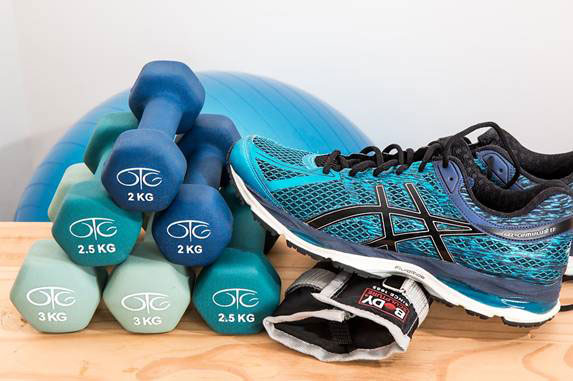 “Rejoice, we’ve won” The messenger said and died.
“Rejoice, we’ve won” The messenger said and died.
Legend says that Pheidippides ran from Athens to Sparta (and back) before running from Marathon to Athens. That’s more than 325 miles in distance.
Today, more than 1000 marathons are held in the memory of Pheidippides.
And, marathons are still growing in popularity, which is evident from the growing numbers of participants and new events. In fact, Giti Tire sponsored one of the most popular marathons this year.
More marathons is a good thing because running has tremendous benefits.
However, long-distance running can take its toll on your body.
You can face problems like blisters, black toenails, or dehydration. Not to forget the serious injuries like runner’s knee, hamstring, shin splints, sprains, or cramps.
There’s no need to worry though. Most of these problems can be prevented.
This guide is meant to help you avoid injuries as you start to prepare for a marathon or long-distance running.
Training:
 Long-distance running is more like a habit. You must let it develop slowly and gradually. It demands the kind of physical and mental toughness one cannot achieve in a matter of days. Other than building the stamina, you will gradually discover the things like the right stride, the right pace, shoes, and diet that suits you.
Long-distance running is more like a habit. You must let it develop slowly and gradually. It demands the kind of physical and mental toughness one cannot achieve in a matter of days. Other than building the stamina, you will gradually discover the things like the right stride, the right pace, shoes, and diet that suits you.
Be Patient:
There’s a fine line between training hard and overtraining.
You need to push yourself but don’t push your body too far. Train hard but give your muscles time to adapt and recover. Most injuries happen because runners do not allow their bodies to recover.
Don’t try to add mileage or improve your time rapidly.
You will often hear the 10% rule that suggests 10% increase in distance or mileage on a weekly basis. However, that is not a hard and fast rule. You can add just 2 percent or 5 percent and that is perfectly fine.
Be Realistic in Goal setting:
Unrealistic goals set you up for failure and the frustration often leads to injuries.
Most beginners get carried away and set unrealistic distance or time goals. The body fails to sustain the sudden load and gives way.
I usually recommend 5 – 6 months of training before the marathon. So, you don’t need to run 5 or 10 miles right from the start. Start from reasonable distances like 2k or 3k, and increase with the passage of time.
Even if you are preparing for a marathon i.e. 26.2 miles, you don’t need to cover the same distance very often in your practice sessions.
Be Consistent:
Inconsistency will not only thwart your progress, it will make you vulnerable to injuries. It’s very important to be consistent. Some runners skip training days because they are busy, tired, or bored. And then, they try to make up by training too hard. You risk injuries by not letting your body adapt.
Other than the consistency in training, it is equally important to adopt an active lifestyle. If you are sitting all day and then going for a long run, it will be very tough for your mind and body.
Rest is important:
By consistency, I don’t mean training every single day of the week and month. You need to have some rest days.
Even more important is a good night’s sleep. Your body needs sleep to recover from the “wear and tear” of workout. Not to forget that adequate sleep is necessary for HGH production. This Growth Hormone helps muscles and bones grow. It also stimulates cell reproduction and regeneration that is important for recovering from injuries.
The posture:
Long distance running is all about finding the right balance.
First, find the right pace. Trying to run a long distance at your optimum speed will build fatigue and lead to injuries. Running too slow will make it hard to achieve your timing goals.
Track your speed as you run at your fastest for a mile or two. Your long distance pace will need to be a tad slower than that. Long strides will stretch your muscles and make you land hard. Short strides and easy pace will improve the efficiency and reduce the chances of injuries.
Relax and maintain a comfortable posture. Keep your arms close and don’t swing unnecessarily.
Mental Conditioning:
“Not over thinking is an expression of genius in sport” – Jay Schulkin
Running is meant to be something that alleviates stress, not build it. No matter how many bad practice days you have the last thing you want is the panic or frustration.
Just like the distance, mental toughness is something you will improve with the passage of time. Be patient and don’t overstrain to compensate for bad days.
Listen to your body:
It is important to know your limitations. Running with a minor injury will usually lead to a major one.
Running is a process that requires a lot of muscles, joints, and bones to work together. Your feet alone have 26 bones and more than 100 muscles. If there’s a problem with any of them, and you are not allowing it to heal, other muscles or joints will have to make up for that, resulting in undue stress, and more injuries.
Take a break when you suspect a problem like pain or inflammation and take precautionary measures.
Warm-up and stretching:
Most of us live a sedentary lifestyle.
It’s good if you are raring to go but sitting all day and going straight for the 5k run is not a wise idea. Prepare yourself before you start. Walk or jog at a leisurely pace to warm-up. Stretch your muscles to increase flexibility and improve posture.
Spending just 10 – 15 minutes on the preparation and warm-up will save you from a lot of injuries.
Running Gear:
 Don’t expect your running shoes to fix all issues. However, right shoes are important because a wrong fit or type of shoes can lead to injuries.
Don’t expect your running shoes to fix all issues. However, right shoes are important because a wrong fit or type of shoes can lead to injuries.
Choosing the right Shoes:
The best running shoes will differ from one person to another. You will be advised specific types of shoes according to your arch type or pronation pattern. However, you shouldn’t choose the shoes based on a simple wet-test. A pair of shoes might feel comfortable in the store but it’s hard to tell if it will feel equally good after some miles. It’s better to spend some time on reading running shoe reviews before making a decision.
Change your shoes after 450 – 500 miles. However, don’t go into a marathon or long run with a brand new shoe.
As earlier mentioned, injuries are not cured or prevented by changing shoes. If you think your shoes are causing injuries or pain, consult a podiatrist or biomechanics expert to get expert advice.
Next is the apparel.
Choose apparel that will keep you from getting too cold or too warm. For summer, use lightweight, comfortable clothes. Avoid fabrics that absorb moisture. It’s worth investing on a tech-shirt (made with synthetic material). For winters, you will need tights, full sleeve tech shirt, headband, and a running jacket.
Diet:

More than 50% of our body is water. Naturally, the excess or deficiency of water can cause problems. It is important to stay hydrated, especially in the hot and humid weather.
Drink two glasses of water an hour before you run. You may drink around 8 – 10 ounce after every 15 – 20 minutes during the run. Sports drinks or gels can also be used during long runs or marathons. Look for dehydration symptoms like cramps or dizziness. Your water requirement can increase or decrease depending on the time and weather.
Don’t drink too much water or you will risk injuries due to hyponatremia.
Coming to the food, it’s very important to give your body the right nourishment. Your body needs the energy to run, recover, and prepare for the next run.
The meals should be high in carbohydrates, especially a day or two before the long run. However, don’t fill yourself up right before the run. Eat some healthy snack right after the long run.
Sprains, strains, and cramps are part of the package. Some pain is inevitable. However, following these guidelines will save you from undue pain and suffering.
How to Improve Your Long Distance Running

Long distance running is good for both the body and the mind when done correctly. When handled incorrectly, it can be damaging to both. For those with goals of running a marathon or competing in a triathlon, perfecting their endurance and form for long distance running is integral to reaching the finish line.
There are lots of small tweaks an athlete can make to help them perform optimally during long distance running. Here are some tips and tricks for improving your long run over time.
Do Interval Runs
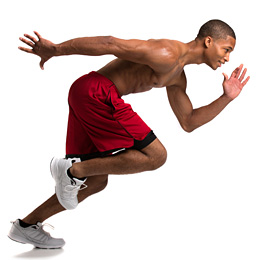 Many beginners use interval runs to get started with their running goals, especially if they’ve never run before. During an interval run, you alternate periods of running with periods of rest. After runners can run consistently without walking breaks for an extended period, they drop this form of training from their repertoire. That’s a big mistake!
Many beginners use interval runs to get started with their running goals, especially if they’ve never run before. During an interval run, you alternate periods of running with periods of rest. After runners can run consistently without walking breaks for an extended period, they drop this form of training from their repertoire. That’s a big mistake!
Even if you’ve successfully run five or ten miles, interval training is still a valuable tool for improving your endurance and speed. Instead of trying to extend your distance each time you run, incorporate a few shorter runs with bursts of sprinting followed by periods of rest. Rather than walking during the rest periods, maintain a slower running pace while focusing on speed during the running bursts. Over time, this will improve your endurance and make long runs easier.
Track Your Heart Rate
 Getting a general idea of your heart rate during a distance run will tell you if you need to adjust your speed to be able to last longer. It’s a common misconception that endurance running and sprinting both result in an elevated heart rate.
Getting a general idea of your heart rate during a distance run will tell you if you need to adjust your speed to be able to last longer. It’s a common misconception that endurance running and sprinting both result in an elevated heart rate.
While your heart rate will come up a bit during an endurance run, especially near the beginning, it should level out and remain steady and comfortable, evenly distributing oxygen throughout your body. If you push yourself too hard, your aerobic energy system won’t be able to keep up, and you’ll tire out quicker.
Sprinting engages your anaerobic energy system, which is what fuels your body when you’ve used up all the oxygen. Feeling some lactic acid build up as you run? That’s because you’ve tipped into the anaerobic zone. Tracking your heart rate will help you correct your pace before you exhaust yourself, extending your endurance.
Get Comfortable Accessories
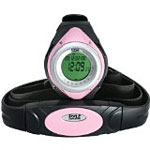 The slightest shifts in weight and how you hold your body can have a significant impact on your long run. For example, carrying a water bottle causes you to close your fist, which is a form of tension that will detract from your run. It also causes a slight shift in weight that could impact your form. Finding a belt that distributes weight along your center of mass will make life much easier.
The slightest shifts in weight and how you hold your body can have a significant impact on your long run. For example, carrying a water bottle causes you to close your fist, which is a form of tension that will detract from your run. It also causes a slight shift in weight that could impact your form. Finding a belt that distributes weight along your center of mass will make life much easier.
It’s important to try out a few different types of water belts and accessories to find what works for you. Some people despise the feeling of a belt and instead opt for hand grips that hold small water bottles on the back of their hands. The more comfortable you are before you leave the house, the more comfortable you’ll be on mile eight.
Hydrate in Advance
 Have you ever wondered how some distance runners manage to head out on a long run without carrying water? The answer is simple: if you aren’t adequately hydrated before you head out on the run, you won’t be hydrated during no matter how many bottles of water you take.
Have you ever wondered how some distance runners manage to head out on a long run without carrying water? The answer is simple: if you aren’t adequately hydrated before you head out on the run, you won’t be hydrated during no matter how many bottles of water you take.
Make sure you’ve had enough water to get you through your run up to two hours before you head out the door. This way, you won’t feel waterlogged and won’t need to break your pace for a bathroom break.
The Bottom Line
These simple changes to your running plan can help improve your pace and endurance over time. You may even notice a shift right away! Give your body what it needs to succeed, and it won’t let you down on race day.
How to Have More Fun as a Trail Runner
 Trail running is one of the most efficient and entertaining ways to stay in shape, but even if you’re passionate about trail running, eventually it can get stale or tedious.
Trail running is one of the most efficient and entertaining ways to stay in shape, but even if you’re passionate about trail running, eventually it can get stale or tedious.
If you keep running the same routes, or if you find yourself unable to make progress on your goals, it’s easy to get frustrated, and/or want to bail on the hobby altogether.
But before that happens, there are some strategies that can help you have a more positive, engaging experience while trail running.
10 Ideas to Keep You Motivated as a Trail Runner
#1. Try New Trails and Distances
This may seem like an obvious tip, but it’s one trail runners often neglect out of laziness. We tend to run the same trails over and over, because they’re close to home or because they have our favorite features, but if you’re always running in the same locations, eventually, you’ll grow tired of them.
You can shake things up by experimenting with new trails and/or new distances. Try starting the trail at a different point, or trying a trail in an entirely different location. You can also run shorter or longer than usual, or change up your distances each day of the week.
#2. Make a Trip of It
It’s even better if you can take your trail running as a trip. Head to a deep forest or mountainous area where you know there are trails you’ve never tried before, and take a few days to enjoy yourself there. Take a portable garage to keep your vehicle in good condition, and consider camping while you’re in the middle of nature. Running while on vacation can remind you why you started this hobby in the first place, and acquaint you with much different terrain.
#3. Run With Partners
If you aren’t used to running with people, consider joining a running group or finding a partner you can run with on a regular basis. Having company on the trail can make you feel better about the experience and give you the distraction of friendly conversation while you’re running. It can also be good motivation to keep you going when you’re at your lowest points; you’re much less likely to flake on a run if someone is counting on you going with them.
#4. Take Your Dog
If you haven’t yet ran your favorite trails with your favorite pooch, perhaps it’s time to teach your best friend a new trick. Obviously your dog will need to be able to keep up so if you’ve got a Chiwawa or Yorkie, the little guys unfortunately just aren’t going to be able to make the cut. However, for those of you with a bigger dog, taking them trail running with you is a great way to boost your enthusiasm by adding a new element of fun to your runs. Running is also obviously a great cardiovascular workout for your dog so it’s a win-win for both of you!
#5. Learn to Meditate
Mindfulness meditation is one of the best skills you can develop as a trail runner. It takes a long time, and significant practice to be able to filter out distractions with nothing more than the power of your own focus, but once you do it, you’ll have greater mental and emotional control in every area of your life. While running, if you can block out distracting and deterring thoughts, you can focus more on the present moment, and enjoy the experience of running, rather than getting too focused on the tedium of your route or the physical strain of the journey.
#6. Invest in Better Gear
You can also spark new motivation by investing in better gear. A new pair of running shoes or some high-tech legwear can make a huge difference in the quality and comfort of your run, especially if you’re used to running in harsh conditions.
#7. Attempt New Challenges
Try to challenge yourself with some unique achievements. You could try to complete a certain loop in a specific amount of time, or use obstacles in your path as an additional challenge. You could even pretend you’re running from zombies, or try to collect items along your route, scavenger hunt style. Any additional “challenge” element here can be useful.
#8. Run With a Toy
Your run can get much more entertaining if you have something other than running to occupy your attention. For example, if you’re running on a paved trail, you can bring along a tennis ball and bounce it as a secondary challenge, or you can use a yo-yo or a fidget toy to occupy your hands.
#9. Run Without (or With) a Gadget
There are pros and cons to running with music, so whichever approach you’re used to, try the opposite. If you’re used to running to the same old playlist, try running without the music and listening to the ambient sounds of nature. If that’s the approach you’re used to, try to put together an energetic playlist to be a source of new inspiration.
#10. Take a Break
Finally, consider taking a break from trail running altogether. Sometimes, a few weeks away from the hobby is all it takes to rebuild your enthusiasm. It’s much better than burning out entirely and coming to hate the sport.
The Bottom Line
It’s perfectly natural to feel bored or tired of running if you’re on the trails often enough, but that doesn’t mean you have to be a victim of that boredom. Try one of these strategies or one of your own, and keep experimenting until you can reawaken your passion.
Eight Essential Winter Running Tips
 Fall is officially here which means winter is just around the corner. If the idea of spending the cold winter months running a treadmill makes you cringe, you’re in luck.
Fall is officially here which means winter is just around the corner. If the idea of spending the cold winter months running a treadmill makes you cringe, you’re in luck.
It’s totally possible to continue running outdoors during the winter. Many people even find that they perform better when it’s cold outside — they lose less sweat and their heart rates tend to stay lower. You’ll just need to take some extra precautions before you hit the pavement.
Listed below are eight essential winter running tips that will help you stay safe (and warm) when the weather outside is frightful.
1. Choose the Right Material
It can be hard to figure out how to dress for winter runs.
For most people, though, the best approach is to wear thin layers of sweat-wicking material. Cotton holds in moisture and will keep you wet throughout your run; go for synthetic materials like polypropylene instead.
For the outermost layer of your running clothing, nylon is a good fabric to choose. It will help protect you from wind and rain or snow without holding in extra heat and moisture.
2. But, Avoid Overdressing
Layers are important during winter runs. But, it’s important to avoid overdressing. Too much fabric can leave you sweaty and overheated, neither of which is ideal for a long run.
It’s normal to feel a bit cold when you first head out on a winter run. However, once you get moving, you’ll warm up without getting too hot.
A handy rule of thumb that many runners stick to is to dress as though it’s twenty degrees warmer than it actually is.
3. Protect Your Hands and Feet
You lose a lot of body heat through your hands and feet. To keep them warm and safe from the elements, be sure to wear a good pair of gloves or mittens. Look for ones that wick away moisture.
To keep your feet warm, try wearing a sweat-wicking sock liner under a warm pair of polar fleece or wool socks.
Just make sure you have enough room in your shoes while wearing them; otherwise, your feet will feel cramped and your runs will be very uncomfortable.
4. Give Your Feet Some Extra TLC
If you have foot problems like plantar fasciitis or bunions, you may find that your pain and discomfort gets worse during the winter. In between runs, it’s important to give your feet some extra attention so you can feel your best during your runs.
Try wearing some toe separators to stretch out your toes and keep the blood flowing properly. You can also roll your feet over a tennis or lacrosse ball to work out any tension.
5. Keep Your Head Covered
You also lose a lot of heat — approximately 7-10 percent of your body heat — through your head. Be sure to wear a hat or thick headband to keep your head and ears warm while you run.
Keeping your head covered will also give your circulatory system more heat that it can then distribute to the rest of your body.
6. Stay Hydrated
It can be hard to keep yourself properly hydrated during the winter months. After all, when it’s cold, the last thing you probably want to do is drink a cold glass of water.
Your chance of dehydration actually increases during the winter, though, because cold air can be drying. To combat this, drink plenty of water before, during, and after your run.
7. Protect Your Skin
Believe it or not, it’s still possible to get sunburned during the winter. If you’re running while the sun’s out (which is generally recommended since temperatures will be warmer), be sure to wear sunscreen.
Wear a lip balm with SPF in it, too, to protect your lips and keep them from getting chapped by the wind or cold air.
8. Don’t Forget to Warm Up
Finally, remember to warm up thoroughly before your runs. Take a few minutes to run up and down the stairs, jump rope, or do some bodyweight exercises (squats, lunges, jumping jacks, etc.).
Running without warming up increases your injury risk and will just leave you feeling colder at the start of your training session.
Safety Tips for Night Runners
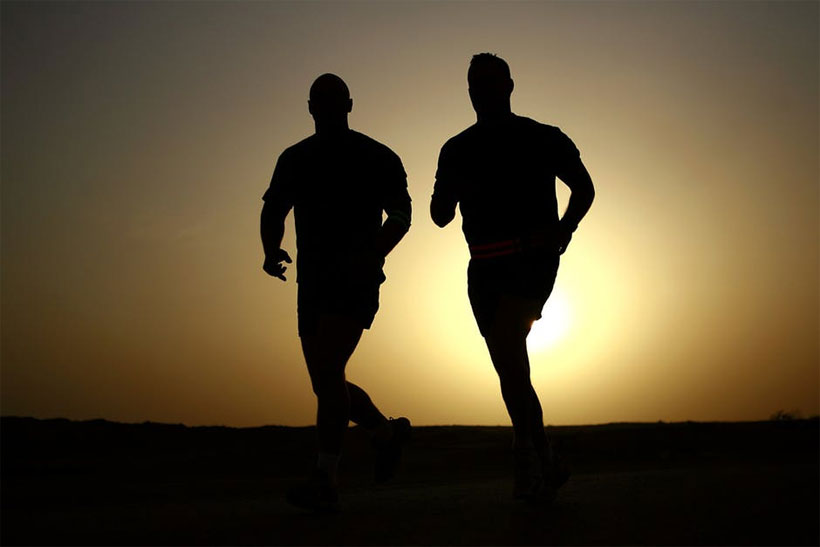 While the brisk arrival of cooler weather and colorful leaves might signal the start of fall for some people, for avid work-out gurus, it’s the shorter and shorter days that you may be more mindful of. If your go-to method for blowing off steam after work is a jog in the evening, you might find yourself running in less and less light as the season goes on.
While the brisk arrival of cooler weather and colorful leaves might signal the start of fall for some people, for avid work-out gurus, it’s the shorter and shorter days that you may be more mindful of. If your go-to method for blowing off steam after work is a jog in the evening, you might find yourself running in less and less light as the season goes on.
The sun starts to set around as early as 6 pm on the east coast in October and then with the end of daylight savings time (U.S.) in early November, you lose even more evening sunlight. So what are late-day runners supposed to do?
Well, nighttime running truly isn’t all the bad if you take proper safety precautions. In fact, night running can be quite nice and offers benefits like:
- Fewer motorists on the road
- Fewer walkers, runners, and cyclists out on your jogging path
- No sun and cooler temperatures (which means more comfortable running)
- New perspectives on familiar routes
If you plan on running outdoors when it is dark out, keep these essential safety tips in mind:
Avoid Headphones
Sure listening to music while you run can keep you amped up, but at night time, it can also reduce your awareness of your surroundings. You want to be on high alert when running in the dark because your visibility may be spotty in areas that aren’t well-lit by street lamps and and signs.
Pack Light
You might not like jogging with anything but your running clothes, however, you will want to rethink this M.O. for night runs. Taking your phone and ID with you on your run will give you the items you need in the event of an emergency. You may need to call someone or if you are injured and unresponsive, emergency personnel will need to easily identify you and get ahold of your family.
Take Familiar Routes
Don’t turn your night run into a time for checking out brand new running routes or local trails. Stick with familiar (but varied) routes that you have run before or drive on frequently to avoid getting lost, attacked, or injured. While you might feel like you can see perfectly fine and memorize new locations in the dark, research shows that the brain can actually manifest non-existent images in the dark without any visual input whatsoever.
Prevent Common Injuries
While routine running is generally low-risk, it is still considered high-impact and can lead to common overuse injuries, like IT band syndrome or Achilles tendonitis, often due to tight and inflamed tendons. Running in the dark can increase your chances of tripping or misstepping as well which can exacerbate an overuse injury (think slippery leaves, potholes, branches on the ground, etc). Give yourself a leg up by wearing orthotic aids that stabilize and support critical joints. These include IT band straps, ankle braces, and knee compression sleeves.
Dress Appropriately
Shorter days likely mean cooler temperatures so night runners will want to start off wearing lightweight, breathable layers of clothing that can be removed as you heat up. Even more critical, however, is wearing apparel that can be easily seen. This might include reflective t-shirts or vests, flashing armbands, or even a runner’s headlamp. To avoid getting slapped by tree branches or having a bug fly in your eye, consider wearing clear glasses and a billed cap too.
Run Against Traffic
You’ve heard it before and experts will keep saying it, running against traffic gives you your best shot at being seen by drivers when road running at night (and really any time). In addition to running against traffic and wearing highly-visible clothing, you will want to aim as much as possible to run on sidewalks with ample street lighting and not on the side or shoulders of roadways.
Ask a Friend to Join You
Pump up the safety factor of your night run by asking a friend to join you. For women, this may be even more crucial. If none of your friends run, consider joining a local night running group that exercises together or even find a dog (yours or a friend’s) that will run with you. The presence of another person or animal could prevent would-be attackers from attempting to hurt you.
Be Smart About Intersections
The truth is that you can never guarantee a driver on the road has seen you running, no matter how much reflective or flashy gear you have on. Play it safe at intersections and always run behind cars that are stopped at stop signs, never in front of them. Try and make visual eye contact and acknowledge drivers on the road as well to more strongly announce your presence too.
Ten Lesser-known Running Tips to Follow
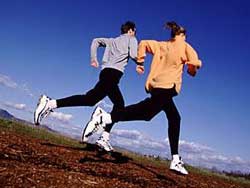
Running is all about getting from point A to point B in the fastest time possible, which is why it doesn’t make sense to read those endless articles littered with technical lingo when you just want to get up and go.
With that in mind, here is the solution: a list of minor running alterations which you can utilize right now without wasting any more of your time.
10 Lesser-known Tips to Follow Immediately
#1. Stop Stretching Before Your Run
Contrary to popular belief, stretching before a run has never been proven to prevent injury. To warm up, rather start with a brisk walk and gradually build up towards your run. Other recommended preparation techniques include rolling your feet on a golf ball every morning and using a foam roller to properly loosen up your thighs, calves, hamstrings, and glutes.
#2. Sync Your Stride to Your Breath
It may feel counterintuitive, but you need to slow your breathing down when you run. If you’re breathing too fast, you are not getting the CO2 completely out of your system, and end up starving your lungs. Once you’ve mastered this, count out a stepping rhythm which matches your breath, as this will help you calculate if you’re running too hard, or should be running harder.
#3. The Area of Your Foot Landing Isn’t That Important
There are plenty of examples of athletes who land on any given part of their foot, which is why you should be concentrating on your alignment instead. As long as your foot arrives directly beneath your hips with a straight spine, you are golden. Another useful trick is to quickly slap your forefoot as you touchdown, as this lessens any forceful joint impact.
#4. Know When to Run Through the Pain
As with any exercise, there are good running pains, and there are bad running pains. After a marathon, for example, it’s unreasonable to expect your legs to feel like their usual selves. The key is to know your own body, ensuring you stretch properly, reducing your speed/mileage if your parts call for it, and wearing a brace if you’re working out with bad knees. If an ache is new or persistent, then apply some ice and take a break, considering a conversation with your doctor to prevent any additional damage.
#5. Music Can Be Your Personal Trainer
By compiling a playlist of your favorite songs which subscribe to the 120 BPM rhythm (or more), you should find your feet driving themselves forward just to keep in time. For bonus pep, select songs with loud, exhilarating lyrical content to truly power yourself along.
#6. Not All Lacing is Made the Same
Everyone’s foot is different, which is why you should not simply accept any standard approach of lacing your footwear. Rather experiment with various styles, taking note of when your feet swell during a run. When in doubt, ask an expert in your local shoe shop for advice. Here are some tips for choosing the perfect running shoes.
#7. Run in Different Directions
Why not train those often ignored muscle/tendon groups by moving sideways on a treadmill? The Commercial 2950 from NordicTrack provides a large enough running surface to make this possible. Also, try running backward uphill to warm those hamstrings and improve your balance. Just make sure you watch out for traffic!
#8. Fueling the Body
If you have a marathon coming up, you’ll need to start preparing your diet roughly four days in advance. Don’t make the mistake of simply piling your plate with more of your usual dinner, and rather load up on carbohydrate-rich foods (pasta, bread, and potatoes) instead. You should also eat a light breakfast 2 – 3 hours before the race (like a banana or bagel) to replace any glycogen lost during the night.
#9. There’s an App for That
No matter what you’re looking to achieve, there is more than likely a running amp just waiting for you to enter its world. Want to keep a record of your runs and compare the results to your friends? Try Strava. Need help to gradually build up a routine? Try Couch to 5K. Want to track all your steps, even when just visiting the store? Try Walker. Want to follow an immersive horror story whilst collecting imaginary items? Try Zombies, Run!. Or at very least, follow other runners on social media, and get inspired by their progress.
#10. Trick Your Brain
If a run feels like the last thing you want to do today, simply manipulate your mind by refusing to think about it. Instead, put on your running gear and go for a leisurely stroll, casually testing out the notion. Joining a fun run, signing up to a marathon, or finding a jogging buddy are all clever methods to add inescapable responsibility to the exercise and remember: if a 45-minute jog sounds like your nightmare, settle for a 20 minute one. It’s much better than doing nothing at all.
Sprinters Workouts for Beginners

If you’re someone who wants to get involved with the sport of sprinting, it’s going to be important to have a look at the various workouts that you should be doing.
Sprinting is a sport that’s going to really come down to maximum development of speed and power, while also having good aerobic capacity to train at a higher intensity level without fatigue.
Achieving these types of fitness qualities will take some hard work and the proper training strategies, but if you get these in place then there’s no reason you can’t see success on your program.
Let’s take a quick look at what you need to know about this unique form of exercise.
Add In Some High Intensity Interval Training
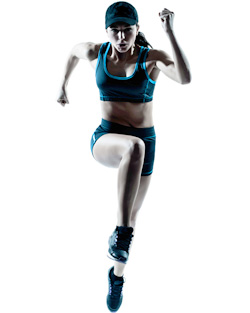 The very first thing that will be a must-have in your sprinters workout is high intensity interval training. Since when sprinting you will be performing at an all out pace, it only makes sense to have this type of training in your workout routine.
The very first thing that will be a must-have in your sprinters workout is high intensity interval training. Since when sprinting you will be performing at an all out pace, it only makes sense to have this type of training in your workout routine.
High intensity interval training will do just that.
With these sessions you’re going to alternate between very intense intervals where you go as hard as you possibly can for 20-30 seconds with active rest intervals where you slow to a walk for 1-2 minutes.
Repeat this process six to ten times to complete the workout and over time you’ll notice an improved ability in your sprinting performance. Like all of the best cardio exercises, your average exercise heart rate is going to determine the overall workout intensity.
Perform Tempo Runs At Least Once A Week
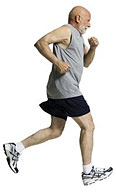 The second type of workout that should be incorporated into your sprinting routine is the tempo run. With the tempo run you’re going to go at a pace that’s bringing you close to the lactate threshold, but one that you can still maintain for a longer period of time.
The second type of workout that should be incorporated into your sprinting routine is the tempo run. With the tempo run you’re going to go at a pace that’s bringing you close to the lactate threshold, but one that you can still maintain for a longer period of time.
These runs should be performed for around 20-30 minutes, at which point fatigue sets in and you have to stop.
The idea behind these workouts is to train your body to work harder for a longer period of time while being resistant to fatigue. As you gain an approved ability to do so, you should begin to notice that you’re not struggling as much with fatigue during your sprints.
Think About Lower Body Power Weight Training
 Finally, the last workout that must be added to the mix is lower body power weight training. This is very similar to a standard weight lifting workout program, only rather than maintaining a constant tempo throughout the lift, you should be focusing on performing the first portion of the exercise as fast as possible, while moving slowly through the second half.
Finally, the last workout that must be added to the mix is lower body power weight training. This is very similar to a standard weight lifting workout program, only rather than maintaining a constant tempo throughout the lift, you should be focusing on performing the first portion of the exercise as fast as possible, while moving slowly through the second half.
This is really going to work to enhance your overall power development better, therefore translating to you being able to sprint much faster as well.
Make sure that you are aiming to lift heavy on these exercises however, as this is key for helping to maintain strength as you work on power.
If you can incorporate all of these sprinters workouts into your overall program, you should definitely be able to see the results that you’re hoping for from your training and you’ll also see noticeable improvements in your sprinting performance.
Sprint Training & Technique: How to Run Faster
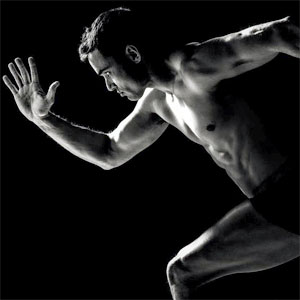
By Shannon Maas, MS – NASM-PES, CES; NCSF-CPT, Level 2 USATF Sprint Coach
In our modern culture, well sculpted bodies garner the most attention, and for a lot of people, that’s a pretty important thing. Ipso facto, this should make sprinting one of the most lucrative endeavors of physical pursuit;A King of Kings among fitness modalities. But this is not so…currently. We have been led astray. We have gone off the path, that for millennia, served our anatomies so well.There are a lot of ways to the fitness and physique mountain top, why does modern conventional wisdom seem to choose the most difficult or least obvious path to the top?
Sprinting, if done right, and I cannot emphasize the word right enough, can be the most efficient tool in your arsenal to creating an optimal body. Sprinting costs almost nothing, it can be extremely fun, can be done in groups or alone, it can be done nearly any place, at any time, in any weather and It is proven to give you one of the biggest hormonal and muscle growth stimulating bangs for your buck.But walking the path of a physiological lion can be fraught with pitfalls and danger. Knowing where to start, how much to do, and how fast to do it are critical variables in making this the best modality possible.
As a University Sprint Coach, it is my job to make my subjects as fast as possible as safely as possible. The visual aspect is simply a byproduct. I am here to help you. I am going to pass along some simple pearls that will help you get up the mountain top in the safest, healthiest way possible…Let’s begin:
Baseline: Zero Step
In sprint coach lingo, the ‘zero’ step is the first foot contact out of the starting blocks. It is the most important step in a short sprint because it sets the tone in a race that can come down to .001 seconds. This is an analogy for your first step. How fit are you? When was the last time you sprinted? In a beer league softball game? Playing soccer with your buddies? Knowing where to start is absolutely essential. The only person that really knows how fit you are, is you.
I would honestly play it very safe when personally assessing yourself. Leave your ego at the door, especially if you’re out of your hormonal prime. The goal, at least for me, is longevity. I want you to look and feel good for as long as you possibly can. Getting out of the gate too fast, too early, will leave you injured and potentially worse off than where you started. For some people, I wouldn’t even recommend jogging for more than 100 meters at a time, if at all. You can get plenty done walking, skipping, or doing drills that are low vibrational impact in nature.
The further you are from the last time you ran full speed, the slower I would start. Even the youngest and best athletes (my college athletes for example), I wouldn’t start running really fast till we’ve undertaken a good 4-8 weeks of tempo controlled development. No one is good injured, and no one is happy hurt. Longevity doesn’t happen without the first step being the smartest one.
Strengthening: ROOT to the FRUIT
My sprint athletes focus on strengthening and density first and foremost. Specifically, I use what I call the “Root to the Fruit” philosophy. I start with the feet and ankles, the ROOT of contact with the ground. We do a ton of dorsi and plantar flexion drills in a very slow and controlled fashion to strengthen the anterior and posterior tibilias and surrounding ankle complex musculature and tendon/ligament/fascial structures. Muscle can be trained fairly quickly (4-6 weeks), but tendons and denser fibers take a bit longer (6-10 weeks) to adapt. These denser structures we want to train and develop first. The reason being that these tissues are be able to handle larger amounts of load at a higher intensity down the road. We also get hidden benefits training these fibers such as elastic reflex (stored elastic energy). If we focus on the roots, we will bear healthier fruits down the road. Be patient, start slow.
Here are some excellent examples of some foot and ankle drills:
ANKLING: Dorsi-Flexion – Toes Out
Cues:
- Keep toes pointed to Sky – Only heel should hit ground
- “Brace” Core – we are always squeezing and engaging our core to create stiffness through the translation point in the body – aka the core
- Squeeze Glutes – this is part of bracing, but should be emphasized in these drills. This will help set the pelvis and create better posture
- Lock the Knees – We want the hips and ankles to do the work, not the quads. Squeezing the glues and locking the knees will help keep the movement in the hips and ankles.
https://www.youtube.com/watch?v=lxZ9auLpQvY
ANKLING – Plantar-Flexion – Tip Toes
Cues:
- Squeeze foot to toe each contact – Stay on ball of foot at minimal
- “Brace” Core – we are always squeezing and engaging our core to create stiffness through the translation point in the body – aka the core
- Squeeze Glutes – this is part of bracing, but should be emphasized in these drills. This will help set the pelvis and create better posture
- Lock the Knees – We want the hips and ankles to do the work, not the quads. Squeezing the glues and locking the knees will help keep the movement in the hips and ankles.
https://www.youtube.com/watch?v=2jNshw9oPV8
Volume: How much?
Volume “Sprinting” is your new best friend. Since we want to develop as much lower limb strength and density as possible, running at low frequencies can help us get these physiological adaptions in a safe way. Especially when first starting sprinting, we can mimic or practice sprinting mechanics at a very slow pace which results in a massively reduced rate and incidence of impact. Many overuse injuries, such as medial tibial stress syndrome (shin splints) are caused by the vibrational impact with the ground. Sprinting slow and controlled helps our body slowly process and adapt to this stress.
We don’t want to go too slow. If we start ‘shortening’ up too much, our gait changes and we look like a distance runner (I don’t like to go much slower than 50%). The difference between sprinting and distance running not only has to do with speed, but with range of motion, especially through hips. Sprinters hit a much larger range of motion through the lumbo-pelvic hip complex, especially flexion and hyper-extension. We can retain a lot of this range of motion by focusing on the power of our foot contact into the ground, and toeing off almost in a bound-like fashion. This is what we call floating or striding.
One of my favorite and easiest Volume workouts is “Straights and Turns.” You can do this on a track, a football or grass field, turf, dirt road…pretty much anywhere. I personally recommend finding as soft a surface as possible, especially when you’re first starting. Sprinting on soft surfaces will help reduce impact injury, and some surfaces, such as beach sand, snow, and thick grass, create more range of motion demand on the ankle joint, thereby creating greater lower limb adaptation. The Caribbean islands produce some of the greatest sprinters in the world (Jamaica, Grenada, Bahamas, Trinidad & Tobago), and most of those athletes train almost exclusively on grass or clay! Here’s what a “Straights and Turns” workout might look like (after a good warm up – which I discuss in a different article):
- 8 Laps – On a Track
- Sprint 100 meters on the straight away – Increasing Intensity (50% – 85%)
- Jog 100 meters on turns
And that’s it. That looks simple, but if done right, that’s two miles in an interval, or HIIT, style of fashion, hitting a high percentage of intensity (ATP-Creatine Phosphate System). It’s safe because you start slow and end your last couple laps at a high intensity. This is not for the beginner. This is an intensity and volume I would do with a lot of sprinting under your belt. For the newbie, there are some very important things to consider when doing a “Straights and Turns” workout:
Pace:
This is simply how fast should you run. I determine pace based off your personal effort. I start all initial straight-reps at 50% or 60% of my personal full speed. I want to mimic my sprinting mechanics as much as possible, but at a lower frequency. The next straight I might run 5-10% faster and so on and so forth. If you are just starting, keep it at a very low percentage no higher 60-70% – depending on the distance you run in your straight.
Recovery:
If you do this workout on a track, the recovery area would be the turn of the track. You can also dictate what sort of recovery you want. If the workout is more aerobic in nature, you might stay at a lower percentage pace-wise on the straight, and jog the turns. If you are hitting a higher intensity on the straight, you might want to walk the turn. You could do active recovery on the turn (ie. A Skips, high knees, or some other drill). You could walk one turn, jog the opposite turn. The range of recovery options is wide and nearly limitless. You can choose how complex or simple you want the recovery to be. I like to mix my recovery up to stave off boredom and stay consciously involved (helps count laps when you get to higher numbers).
Frequency:
How often should you do this workout? If you are new, you should do this workout at least 1 time a week. You should do it no more than 3 times a week (that’s a lot). Do it about every 3-5 days, with no more than 7 days between sessions. If you do a higher intensity version, take no less than 4 days.
Intensity: How Fast?
This is huge. I rarely go over 90% personally. And if I go at that effort pace, I go for a short distance –no longer than 30 meters. Intensity is a gamble. The higher the effort pace %, the higher the chance of acute injury. The tradeoff is, the faster you go, the more hormonal response and greater the muscle adaptation we get. I would not even think of trying to hit 90% pace until you have a good 6-8 weeks of controlled volume under your belt. Remember, longevity is our goal. The more you roll the dice with higher intensities, the more we chance our longevity.
At higher percentages, I usually model my workouts on Acceleration. Overcoming gravity and inertia when starting from a standstill creates a huge muscular demand. There are all sorts of acceleration workouts and different variables you can plug in. A great acceleration work out we do involves butcher sleds (with light loads) where we march in our “Drive Phase” posture, then do a rep for 15 meters at 90%, then finish off with a 90% 30 meter sprint. Since this article is in the interest of beginner safety, I will get into higher intensity workouts later.
For now just understand that the faster you go, the greater the chance of something bad happening.
Recovery: Most Important
We only adapt when we rest. The quality of rest is determined by your sleep, your nutrition, the frequency, or how often, you work out, etc. The higher intensity, or the larger the volume the workout, the longer you should recover. The highest twitch workout out there, depth “shock” jumps (a form of plyometric), necessitates at least a 48-72 hour recovery period before repeating a similar workout. You should also pyrmadize, or work on a fitness-fatigue protocol by taking extended rest in off periods, or when you feel you are in a large physiological defecit.
Soft tissue work, such as massage or myofascial release (foam rolling, release), flexibility and mobility work should be employed as part of your recovery strategy. I emphasize the concept of less is more, especially if you are thinking in regards to longevity.
How Yoga and Running Make a Winning Combination
 Ask any runner on the street if she’d prefer to log as many miles as she can or take time away from her training each week to hit her yoga mat, and the answer would be irrefutable: most runners want to log all the miles, all the time. It typically isn’t until and unless a runner gets sidelined with an injury that she’ll begin incorporate cross-training and strengthening exercises, like yoga, into her routine.
Ask any runner on the street if she’d prefer to log as many miles as she can or take time away from her training each week to hit her yoga mat, and the answer would be irrefutable: most runners want to log all the miles, all the time. It typically isn’t until and unless a runner gets sidelined with an injury that she’ll begin incorporate cross-training and strengthening exercises, like yoga, into her routine.
Yoga may sound antithetical to many runners, but truly: in order to get stronger, runners ought to slow down more. So many runners incorrectly think that in order to become as fast and strong as possible, they should be running as hard and as much as they humanly can. They don’t realize that more often than not, this spells disaster and, if nothing else, overuse niggles, if not full-blown injuries.
Below, I’ll describe in more detail how yoga and running can make a winning combination. The key ingredients to this winning duo include the following:
Yoga Can Help to Rectify Runners’ Many Muscular Imbalances
Typically speaking, runners only really move in one plane of motion. As a result, they become really strong in that one particular plane, and their muscles, also, become really strong — but only there. For example, runners’ quadriceps muscles may become super strong, but their opposing muscles, the hamstrings, may remain severely sore, weak, and tight. Runners who incorporate a regular yoga practice into their routine can help to rectify these imbalances and can eventually help correct them. In doing so, runners can become stronger and more balanced and thus, more injury-proof in the (proverbial and literal) long run.
Yoga Can be an Effective Way to Strengthen Runners’ Core Muscles
Runners know how important it is to have a strong core, and that goes beyond having a six-pack abs. Having a strong core means having strong stomach, back, and trunk muscles, and yoga is incredibly effective at isolating those muscles and working them appropriately.
Yoga Can Be an Excellent Avenue to Hone runners’ Mental Games
A lot of people say that running is 90% mental, so it goes without saying that it’s critical that runners’ mental games are on point at any given time. Many runners, however, fail to spend an appropriate amount of time navigating the murky waters of their mental fitness, and it isn’t until they give up before they should and underperform in key workouts and races that they realize that their mental fitness isn’t up to par. Yoga, on the other hand, with its slower-paced and deliberate movements and meditative vibes, can be an excellent avenue through which runners can work on their mental fitness. Yoga often forces runners to slow down and focus on the here-and-now, not hypothesizing or catastrophizing about how they might feel in the future.
There Are Plenty of Running-Specific Yoga Practices Out There
Finally, as running has gotten more popular over the past decade, devout yogis seem to have picked up on this potential and have thus released all sorts of running-yoga collaborations. Whether you want to attend a “yoga for runners” class at a brick-and-mortar yoga studio in your community or follow-along with a youtube “yoga for runners” video from the comfort of your living room, there is something out there for everyone. Sometimes runners fear that they won’t be able to keep pace with the yoga instructors’ movements, but oftentimes “yoga for runners” -type classes are scaled to exactly meet runners’ bodies’ demands, inflexibility and all.
Runners don’t need to sacrifice tons of their weekly mileage to accommodate a new yoga practice. Instead, simply incorporating even a few yoga moves into their daily stretching and flexibility routine can still allow them to reap the benefits.
It’s also worth mentioning that when you’re first starting yoga, you likely will feel uncomfortable or silly and perhaps even self-conscious about your perceived abilities — or lack thereof — with your new routine. Don’t sweat it! Remember that we were all newbies once. Take solace in your courage to do something new, to supplement your already existing fitness routine with something that’ll be good for both your body and your mind.
Whether you’re going to add a ten-minute yoga flow to the end of your daily runs or hit a studio for a 90-minute class each week, incorporating yoga into your running routine can potentially keep you free from injuries and burn-out and help you to feel stronger overall.
Yoga has been around for millennia, virtually the same as running, and millions of people the world over can’t be wrong about its effects on their health and well-being. Try it on for size with regards to your running, and you, too, may be singing its praises soon.
Author Bio: Jane Grates
A certified hiker and runner. Performing at the sweet spot between minimalism and purpose to develop visual solutions that inform and persuade. She also writes reviews on sites such as Runnerclick, GearWeAre and ThatSweetGift.
About Michael Behnken
Mike Behnken is a personal trainer who holds multiple NASM certifications and a MS in Exercise Science. Mike loves fitness, travel, and photography among many other interests.

